Discover Egypts Temples And Tombs
My 9 Day Adventure Tour with Egyptoria
Day 1.
After a 2 hour 15 minute flight from IstanbuI I arrived at Cairo airport at 08:45am, 21/01/2019. Once I had filled in my arrival card and been to the Bank desk to buy my Visa stamp (you can also change money up here), I made my way through passport control. There were many English speaking staff ready to help everyone so the process was fast and easy. When I arrived at the baggage collection I could see my suitcase on the conveyerbelt so there was no waiting about here! Excitedly I made my way outside the building.
Once outside the building I could see 2 representatives from egyptoria Tom and Islam, waiting for my arrival. They greeted me with a lovely bunch of flowers, which made me feel so welcome, and had waited until my arrival for their breakfast as they planned to whisk me off to enjoy a surprise traditional Egyptian breakfast with them.
Filling in your arrival card at the airport.

Paying for your visa stamp and money exchange desk.
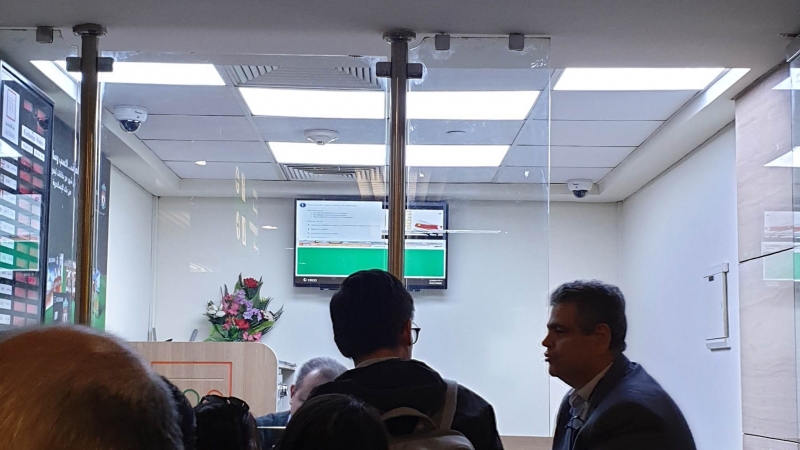
Traditional Egyptian Breakfast

El Tahiri Square, Cairo

Downtown Cairo
After breakfast they checked me in at the hotel where I would be staying for one night before moving on to Aswan. I spent some time unwinding from my journey at the hotel for a few hours then we headed to Downtown Cairo for Dinner at the popular Gad’s restaurant and a walk-about. For dinner I chose the meat and vegetable tagine with a special style of aromatic rice with vegetables, sultanas and full of spicy flavours. There was also a basket of hot small round puffed up bread with sesame seeds in which you can dip in the sauces. Yummy!
Gad is a well-known fast food establishment in Egypt and is loved in all Cairo neighbourhoods for its big red sign and its tasty, quick fowl and taameya sandwiches. The Downtown branch of this Cairo restaurant provides a new dimension of the Gad experience for diners looking for more than a mere sandwich off the street.
Gad’s sit-down dining room is a great stop for hungry Downtowners and an excellent choice for a rustic and delicious Cairo-style fetar. Though a simple restaurant, menu options are quite varied with a wide selection of meat, fish and chicken dishes along with salads and the standard fowl and taameya options. Something for everyone it seems.
The upstairs dining room at Gad Tahrir is a no-frills affair with paper napkins, plastic cups and fast turnover. Drink selections are limited to water, sodas and fresh lemon, but they are all served ice cold and make a good accompaniment to the hearty food. The piping hot homemade bread with black sesame is a highlight that comes with every meal.
Other culinary highlights at Gad include the tehina salad, and the grilled chicken and kofta plates served with rice, salad and fries. The main courses on offer make for a satisfying lunch or fetar, while the selection of salads and the famous fowl and taameya are perfect for a light dinner or sohour.
A foul or taameya sandwich will always be the cheapest bet, but the prices in Gad’s dining room are more than affordable. Dinner for two with drinks tallies up to between 50LE to 60LE.
Gad is very much a local haunt, with waiters and regular customers engaging in friendly banter. This is part of what makes this place special; cheap and friendly local hangouts are, unfortunately, a dying breed in Cairo’s restaurant scene.
Cairo Egypt Museum glows so beautifully at night.
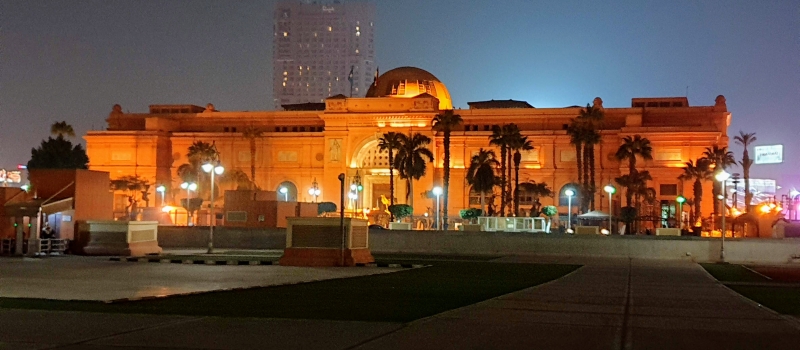
I first visited Cairo's Egypt Museum in April 2009. It's one of the most interesting museums I've ever visited.

Downtown, El Tahiri Square, Cairo.
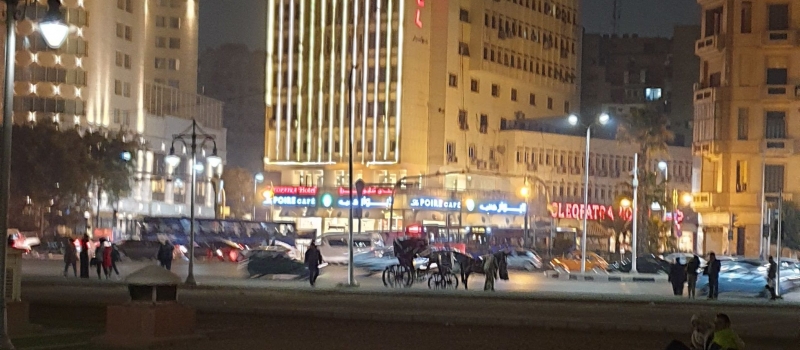
Dinner at Gad's. Gad is one of Egypt's famous restaurants.
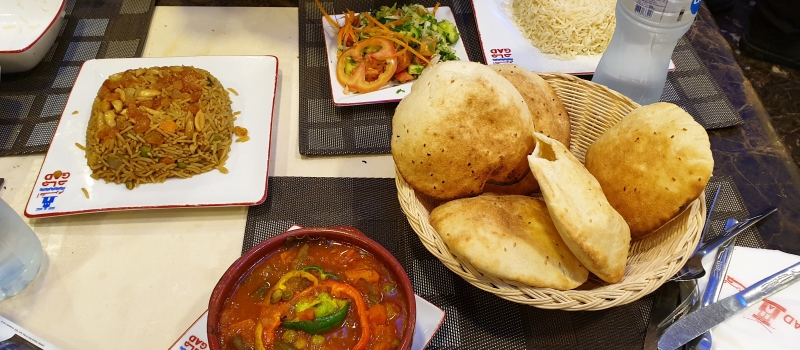
Meat and Veg Tagine

Chicken Shish with delicious spicy aromatic rice.
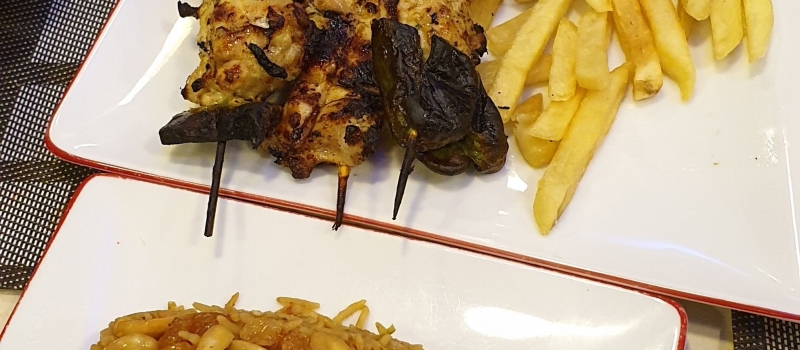
Umm Kalthoum Cafe
On our walk-about we stopped for some super night photos of Cairo’s famous Egypt Museum, which is next to the Midan Tahrir, the central square of Downtown Cairo, and street photos and videos. Further into the walk I noticed many spice stores, clothes shops and many, many shoe shops, so if you’re a fan of shoes this might be the place to come (lol), and of course shisha cafes, one of which we stopped at was called Oum Kalthoum after a famous female singer (also seen spelt as Umm Kulthüm and Umm Kalthoum ). I requested coffee and to my surprise a Turkish coffee appeared, and very nice it was too! I soon realised that Turkish coffee is served everyhwere in Egypt.
Not only was Oum Kalthoum an internationally renowned Egyptian singer, but she was also songwriter, and film actress active from the 1920s to the 1970s. She was given the honorific title Kawkab A Sharq “Star of the Orient”.
There is more than one coffeehouse in Cairo named after the legendary Egyptian singer Umm Kalthoum, but none can match the history of the four-floor establishment on Orabi Street, not far from Tawfiqia Square in downtown. The Egyptian singer mesmerized Arab audiences from the Persian Gulf to Morocco for half a century. She was one of the most famous Arab singers and public personalities of the 20th century.
Whether the coffee is better in this particular cafe than the others needs to be tried and tested so, I guess I’ll have to try them all next time I visit! Lol!
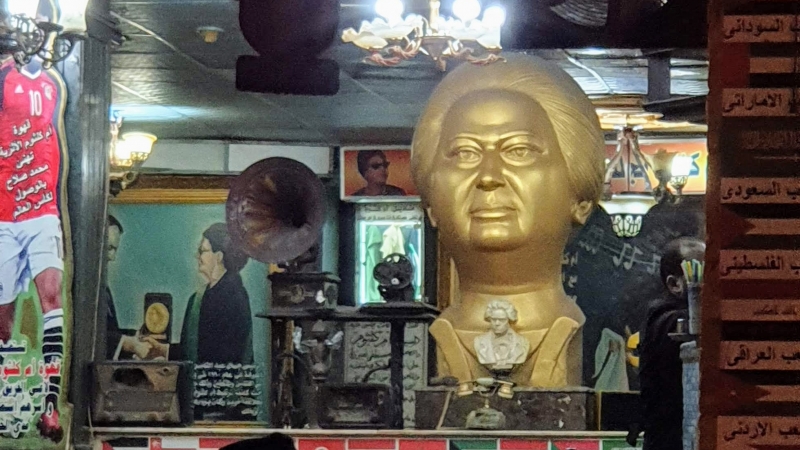



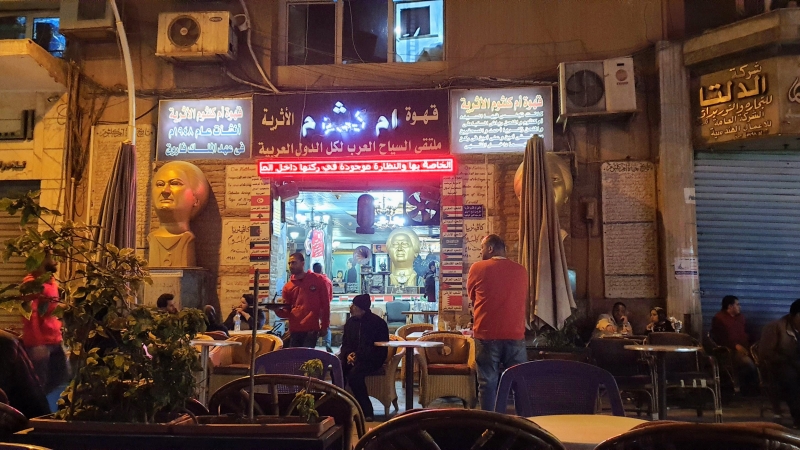


Downtown, El Tahiri Square, Cairo.



If you’re a fan of museums then a visit to Cairo’s Egyptian Museum could keep you busy for the whole day as they have a staggering collection of antiquities, of which you’ll actually need a lifetime to see all that’s on display. Though if you’re pushed for time, make a bee-line straight for the Tutankhamun Galleries. The treasures displayed here were all found in the tomb of Tutankhamun. The tomb, discovered by Howard Carter in the Valley of the Kings in 1922, contained the largest and richest assemblage of grave goods ever found intact in an Egyptian tomb. I didn’t see as much as I wanted to here as we were pushed for time when I visited in 2009 so I plan to return and spend a whole day (or nearly, lol) once the GEM is open.
Latest news of the Grand Egyptian Museum (GEM) due to open in 2020.
The 5.2-million-square-foot structure will become the world’s largest museum devoted to a single civilization. On 9 June 2018 in Cairo, the general supervisor of the Grand Egyptian Museum Tarek Tawfik (GEM) spoke of the partial opening of the museum which will be in the first quarter of 2019. The Grand Egyptian Museum will witness for the first time the display of all Tutankhamun’s artifacts gathered in one place which amount to more than 5,000 pieces.
GEM’s lobby will host the statue of King Ramesses II and the column of his son King Merneptah, the grand staircase will include 87 royal statues and large architectural elements including a statue of Kings Khafre, Menkaure, Senusret, Akhenaten and Amenhotep III.
A visit to Egypt would not be complete without being entranced by a timeless majestic experience of the Pyramids.
Day 2.
January 22nd. We visited the Sakkara Step Pyramid in the morning, though there was a fair amount of mist in the air and wondered if we’d be able to see much. Thankfully it cleared in time so we were able to take some amazing shots and videos. In January and February there are a fair amount of tourists visiting as in the summer time it’s too hot to be walking around visiting the Pyramids and Temples etc. outside though if you arrive early at the ticket desk you shouldn’t have to wait long.
Constructed at Sakkara around 5,000 years ago, the Step Pyramid of Djoser was the first pyramid the Egyptians built.
The pyramid is at the center of a complex 37 acres (15 hectares) in size. This complex is surrounded by a recessed limestone wall that contains 13 fake doorways as well as the real colonnade entrance on the southeast side.
Entrance to Sakkara before the ticket booth.

Leading up to the entrance of Sakkara Ticket Booth.

Sakkara Step Pyramid Ticket Booth.

This Temple is situated to the north of the Step Pyramid.

The Complex.
A temple lies on the north side of the pyramid along with a statue of the king. The statue is surrounded by a small stone structure known as a “serdab,” his eyes peeking out through a hole. To the south of the pyramid lies a great court, with an altar and stones identified as boundary markers.
A number of facade “dummy” buildings were constructed in the complex, including a series of chapels in the southeast as well as north and south pavilions on the east side of the pyramid. These structures would have served ritual purposes and, apparently, they appear to have been partly buried by their builders.
A dummy chapel at the Hep-Sed court of the Step Pyramid of Djoser.
In the southeast side of the complex, next to the dummy chapels, is a court that would have allowed the king to enact the Heb-Sed jubilee festival, presumably in the afterlife. At the southern end of the complex lies the enigmatic “south tomb,” with a chapel. It contains a series of tunnels that mimic those found beneath the pyramid itself. What was buried there is still a mystery waiting to be revealed.
King’s burial chamber.
Beneath the step pyramid is a bewildering array of tunnels and chambers, the center of which is a 90-foot-deep (28 meters) shaft that, at its bottom, contains the burial chamber of king Djoser. Recent conservation work in the burial chamber reveals fragments of the king’s granite sarcophagus, the names of queens still legible.
It is said that the step pyramid is the only pyramid in the Old Kingdom that 11 of the king’s daughters were buried inside. The vault would have initially been decorated with limestone blocks containing five pointed stars, creating a star-filled ceiling. However, for reasons unknown, this decoration was scrapped by its builders in favour of a simpler granite burial chamber.
Tunnels and underground ‘palace.’
Two passages lead underground and branch off in three directions. They contain three magazine galleries, a special tunnel for food offerings, and an uncompleted chamber that may have acted as an underground “palace” of sorts, albeit one for the afterlife. Three false doors contain inscribed stone slabs showing the king engaged in rituals. The chamber is decorated with thousands of blue faience tiles (Egyptian faience was a ceramic material created to resemble precious stones, such as turquoise and lapis lazuli), imitating the reed matting found in the king’s real life palace in Memphis.
Yet another tunnel, starting on the east side of the pyramid, contains 40,000 stone vessels, many of them belonging to the king’s ancestors. Sarcophagi and human remains were also found. The step pyramid is in a fragile state with estimates suggesting that, without conservation work, the tunnels beneath the pyramid could collapse, the monument being largely gone in a couple of decades.
Mark of Respect.
The construction of the step pyramid would see the beginning of an ambitious pyramid building program that would culminate with the Great Pyramids at Giza. Imhotep, known as the ‘chief of sculptors’ who designed the step pyramid, would eventually be regarded as a kind of god.
Sakkara Step Pyramid

Sakkara Step Pyramid and Temple
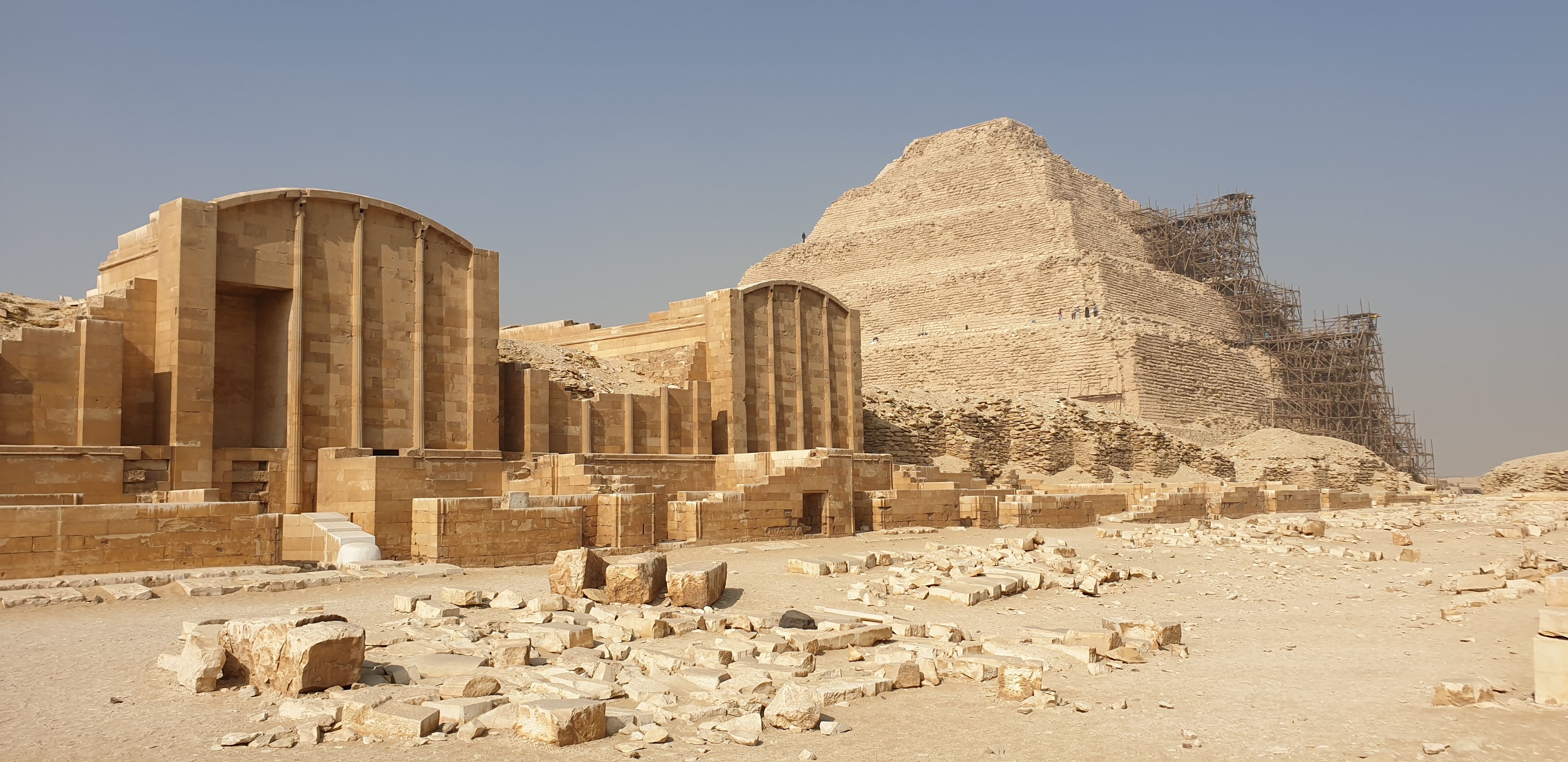
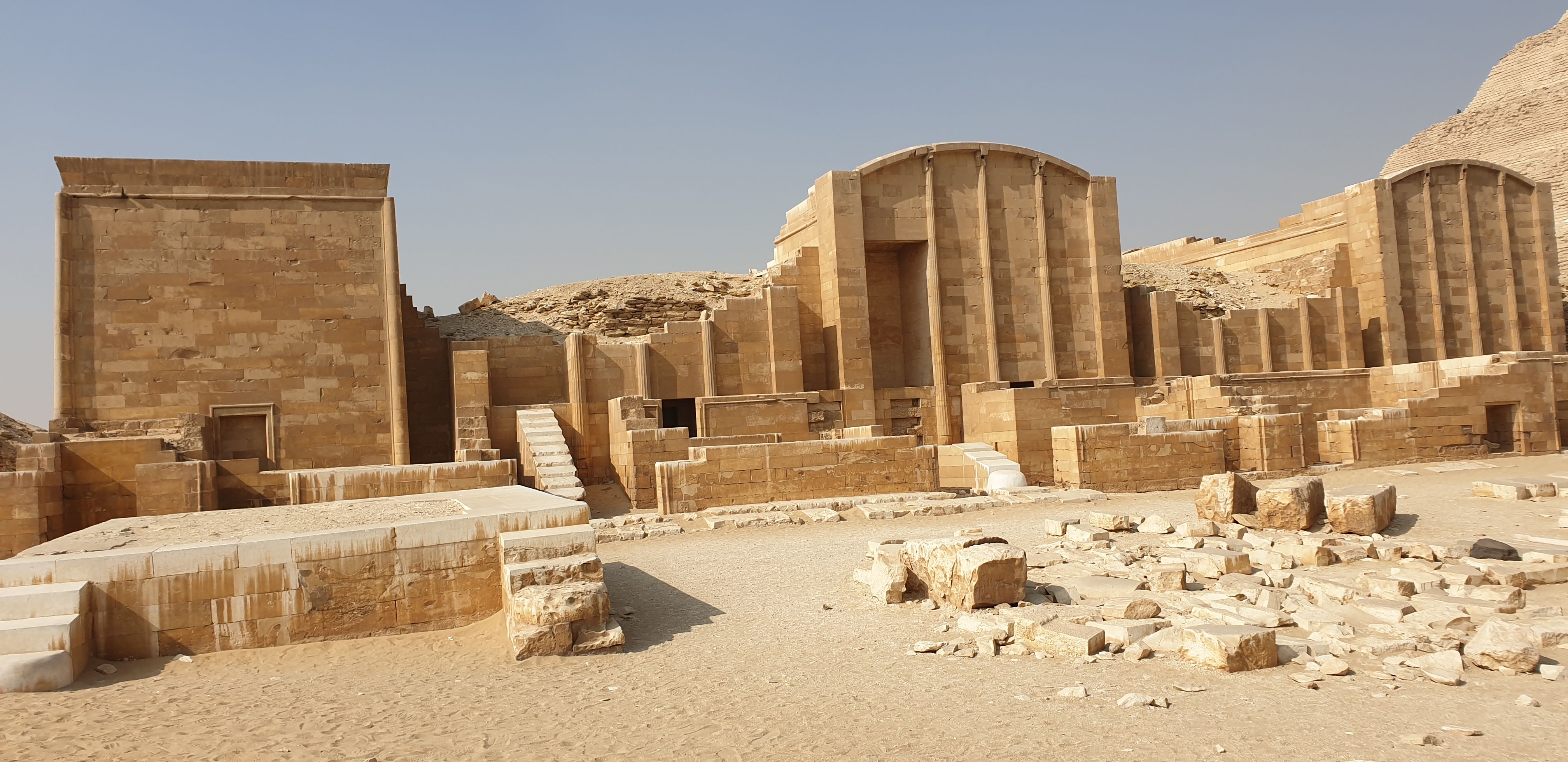

Me! At Sakkara

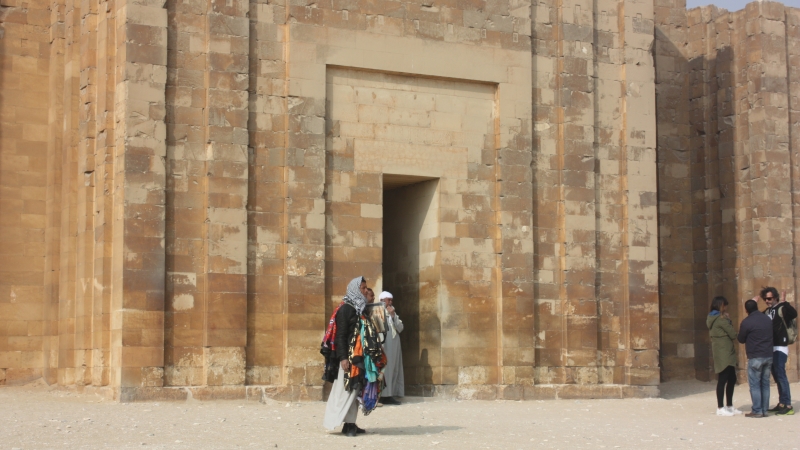
A few souvenirs available before heading into the temple.

Panoramic view.

THE PYRAMIDS OF GIZA
An afternoon visit and my 2nd time here on 22/01/2019. The weather was around 24 degrees and a little breezy. Egypt is very popular for Korean tourists it seems at the moment, turning up in large groups with their (sun) brollies and mouth masks. The camels and donkeys are plentiful here and wait patiently for their next riders, while the friendly Egyptian sellers all walk around trying to gain the attention of the on-coming tourists with their colourful books, T-shirts, scarves and souvenirs announcing their ‘special cheap price, only $2’!
All three of Giza’s famous pyramids were built by pharoahs, the tallest of which (the Great Pyramid) by Khufu, the one in the background by Khafre and in the foreground by Menkaure at the approximate time around 2550BC – 2490BC. Khufu’s Pyramid, built around 4,500 years ago during the 4th dynasty and made of limestone and granite is the oldest of the Seven Wonders of the Ancient World, and the only one to remain largely intact.
It’s an amazing feeling walking right next to these wonders of the world trying to imagine how life was for these people all those thousands of years ago.
Experience a Camel or Donkey ride around the Pyramids

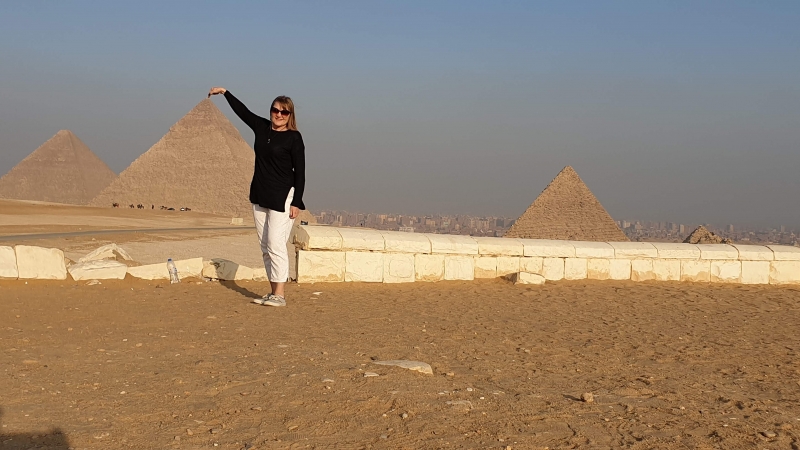
Tourists climbing the Great Pyramid

Kahfre’s Pyramid is situated on the Giza Plateau on the west banks of the River Nile. His valley temple also has an enigmatic monument nearby known as the Sphinx, with an uncompleted temple dedicated to it. The mythical reclining Sphinx is a 241-foot (74 m) long monument carved out of the limestone bedrock of the Giza Plateau. It has the face of a man and the body of a lion.
The Giza Plateau is a great placed for taking amazing video footage and photos, so make sure you allow plenty of time for this whether you’re a professional photographer, amateur or just a selfie-taker.
The Solar Boat Museum is also situated here and well worth visiting. As you walk around the Giza Plateau near the Grand Pyramid you should notice a very long hole in the ground where the boat was discovered and had been there for 5,000 years. It was buried for the purpose of transporting Khufu’s spirit to the heavens.
solar Boat Museum

The hole where the solar boat was discovdered
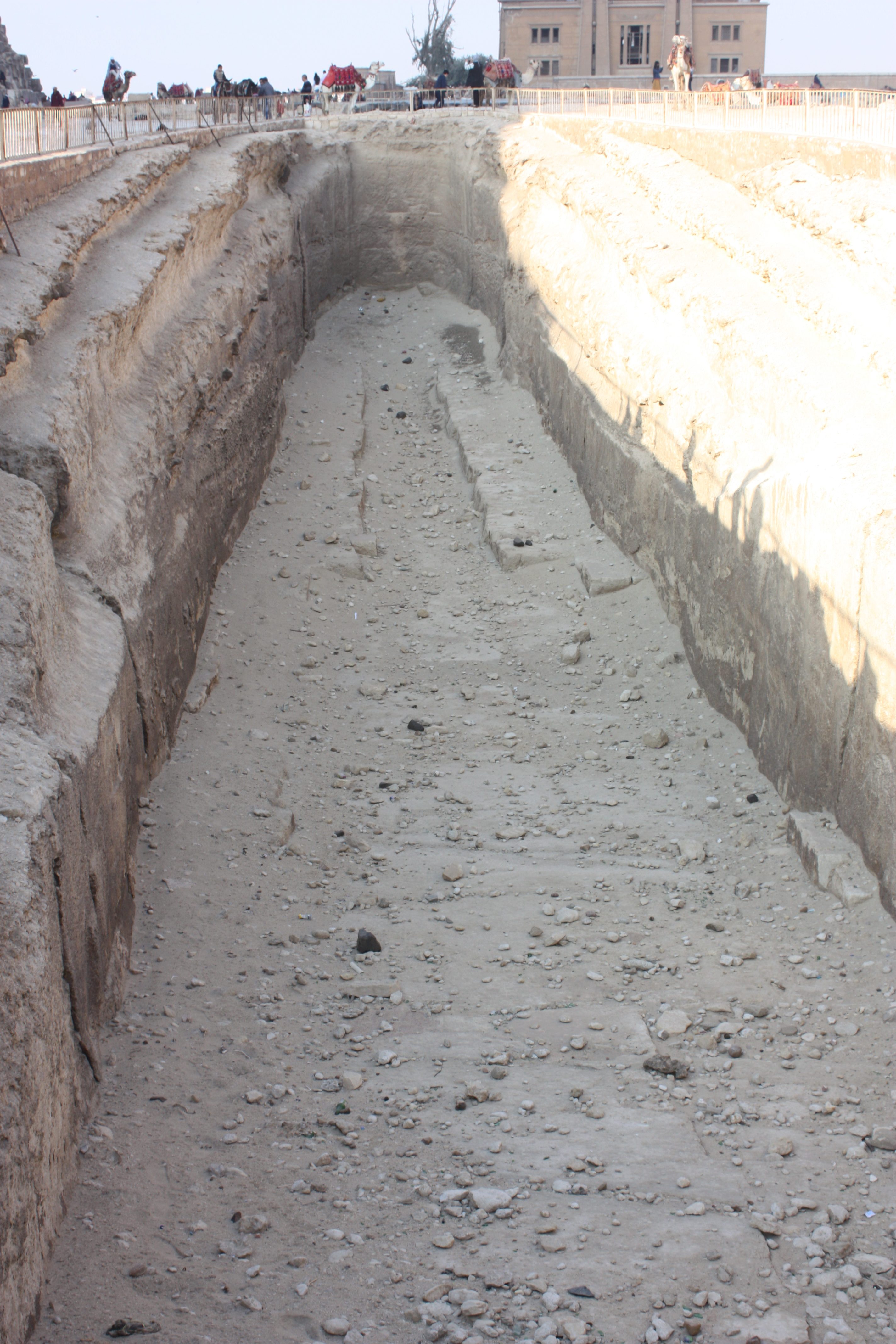
Me trying to get the perfect shot
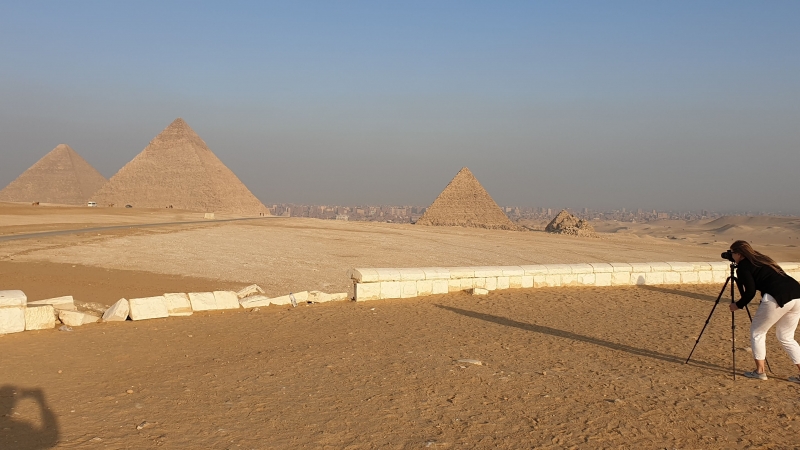
I highly recommend visiting here when in Egypt and I for one will never tire of visiting sites like this. As for Meditation, I can certainly understand why some people pay a lot of money to feel the power of meditation inside the Pyramids . There are tour companies such as Egyptoria who do Tours for meditation inside a Pyramid. I can also assist you should you need any help in booking a tour in Egypt.
A warning for you if you’re not aware – I have learnt that if an Egyptian seller, donkey or camel owner asks you to take a photo of him or with you, or he might say he will take a photo of you and your partner/family with your camera, DO NOT GIVE HIM YOUR CAMERA/PHONE, as he will want money from you before he gives it back (unless you don’t mind giving him money). He may say to you ‘take a photo of me on my camel/donkey if you want,’ then he will ask to see the photo. He will take the camera, look at the photo and then ask for money before giving it back, so just be aware. This is just one of the ways they try to trick money from tourists.
You should always haggle the price of the souvenirs and books as the price is normally way over the top. And, believe it or not, they actually want you to haggle!
The Great Sphynx on the Giza Plataux


A group of tourists on a camel trek.

Marriot Mena House Cairo
Here’s a glimps of one of the 5* Hotels that Egyptoria’s Package customers can choose to stay at if availability allows. It’s very close to the Pyramids and you could even be lucky enough to get a room which has a balcony with a Pyramid view. I can highly recommend this hotel for all kinds of stays.
The Marriot Mena House comprises of 331 luxury rooms and suites, many of which have views of the Pyramids, delightful gardens or swimming pool view. There is a varied choice of meals from the 4 restaurants, 2 of which serve International cuisine, one Italian and one Indian, lounges, with indoor and outdoor meeting and banquet facilities, an indoor heated swimming pool and health club.
You could say this hotel is offering a wonderful and unique location by being situated at the foot of the Pyramids offering one of a kind accommodation experience with unmatched views and service authenticity. I felt it had a wonderful and relaxed atmosphere throughout the whole grounds. I even had the pleasure of meeting the hotel Director of Marketing Communications for a cup of tea and chat, where he told me many interesting facts about the hotel from over the past decades and famous people who have stayed there.
View from the balcony of a double room at 5* Marriot Mena Hotel, Giza.

5* Marriot Mena Hotel, Giza.
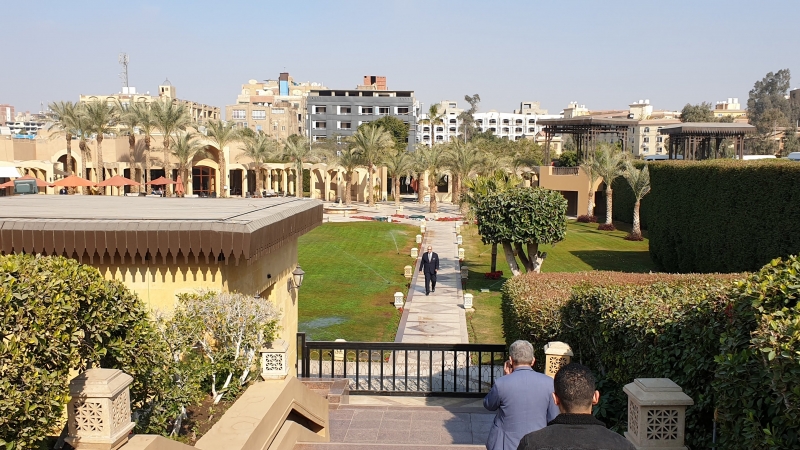
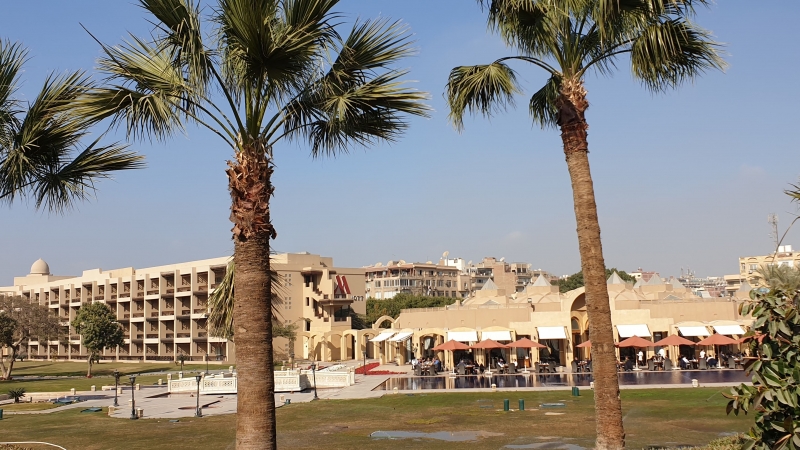

The outside pool and gardens
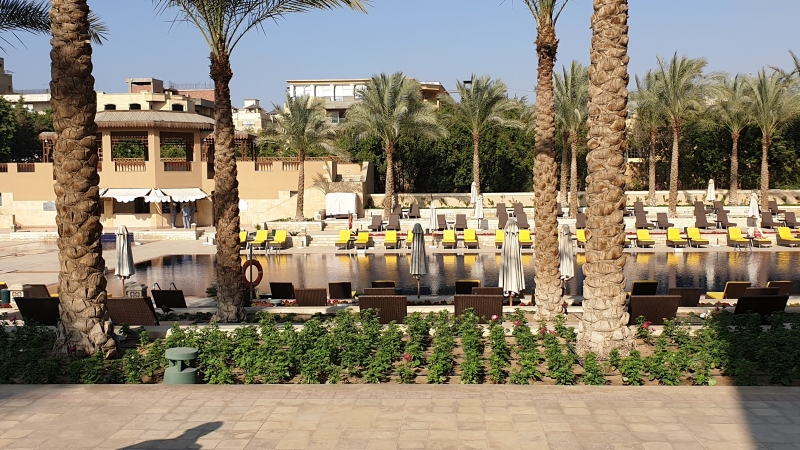
Dining by the water feature with a magnificent view of The Great Pyramid

View of one of the restaurants looking out over the water feature

View of the 5* Marriot Mena Hotel from one of the beautifully kept gardens
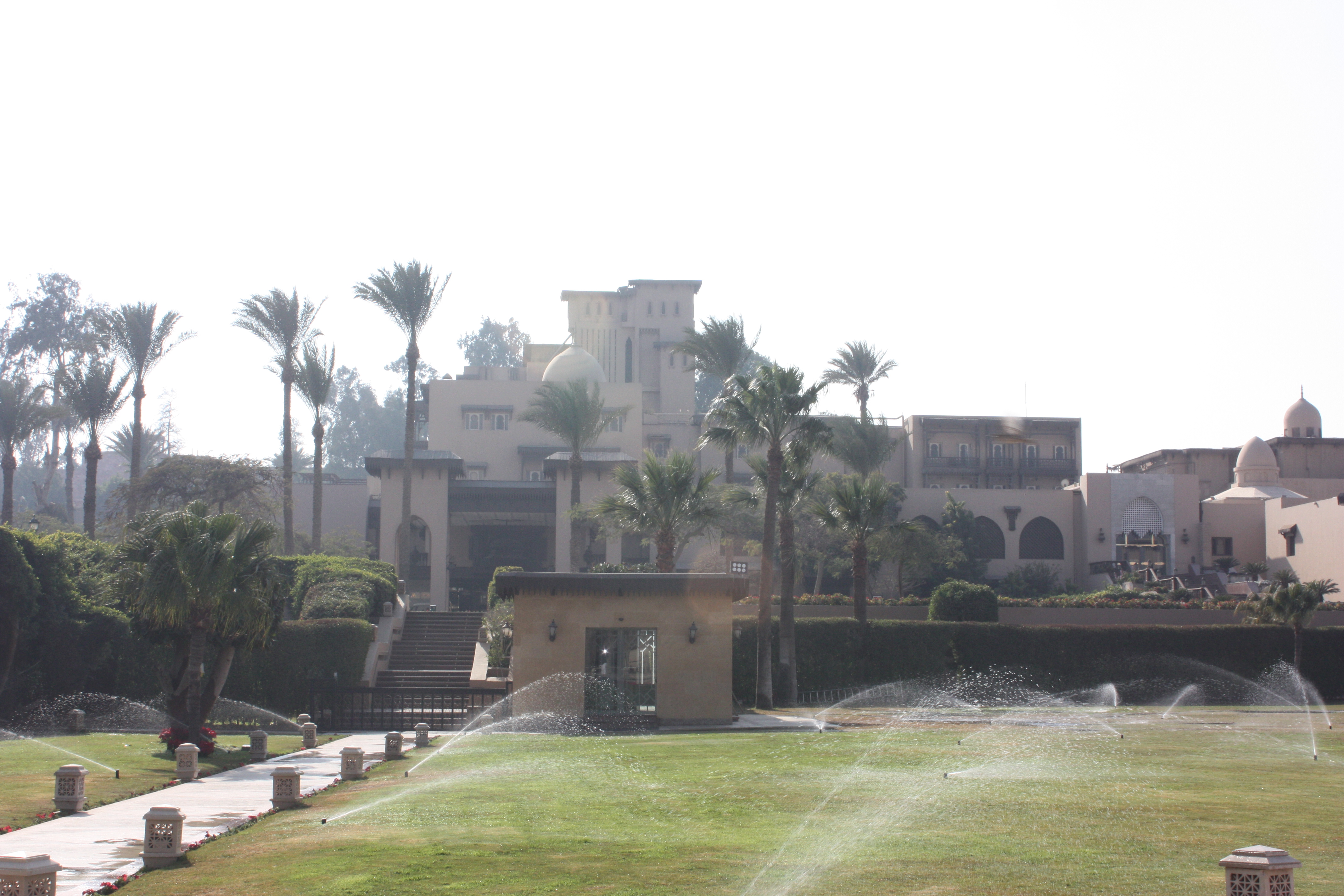
Traveled to Aswan. Then checked into the Pyramisa Isis Corniche Hotel for one night beside the River Nile.
Day3.
Philae Temple.
We traveled to the Philae Temple by the traditional Egyptian Felucca boat. The weather was beautifully warm and sunny, around 26 degrees (see video).
This magnificent Temple was built for the Goddess Isis by the Ancient Egyptians though, unfortunately it almost became completely submerged after the first Aswan dam was built in 1906, and it was not until the seventies that many nations attempted to save the Temple. All these countries, together with UNESCO, selected a suitable place for the move, but they had to wait until the completion of the High Dam, in 1971, which would stabilize the level of the water.
The new island was called Egilica (also called Agilika), and it was completely reshaped to imitate Philae Island as closely as possible. In order to make the move to the new Island a cofferdam was built around the temple and the water was drained away. Next, the temple was painstakingly dismantled and transferred, stone by stone, from the submerged Philea Island to the redesigned Egilica Island. Each and every stone had to be numbered and then replaced, in the same position, in the new location. It was a massive, and very complicated yet successful, project taking over 9 years to be accomplished.
Finally, the Temple of Philae was reopened in 1980!
The Temple of Isis is one of the greatest Temples in Egypt, built in the same style as the Temples of the New Kingdom and occupies about a quarter of the island. I actually felt quite overwhelmed by it’s magnificence and walked about with a huge smile on my faced all the time I was there. I could have stayed there for hours and hours gazing at the whole site. So, of course I would highly recommend you take the opportunity to come and spend time here as there’s so much history to take in and photos and videos to take. Afterwards we took the felucca back to the entrance.
In the evening we strolled through the main shopping area and until we found a restaurant that served fish. And very nice it was too! Later we went on a walk-about and stopped to enjoy yet another Turkish coffee before returning to the hotel for an early night to prepare for another early start the following morning.
Philae Temple
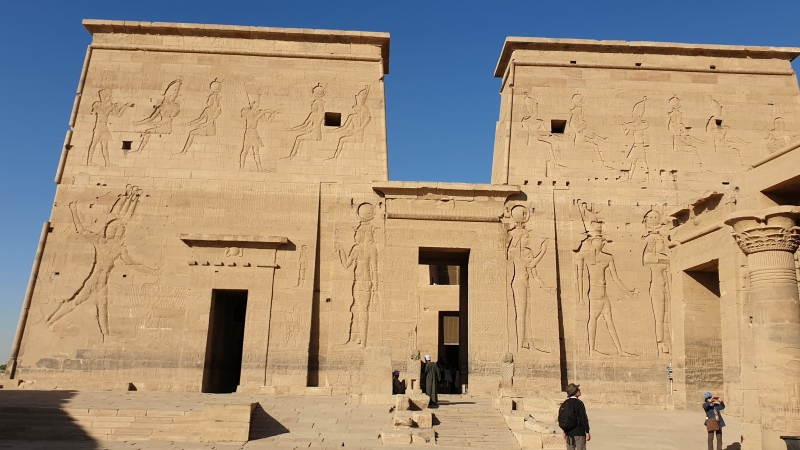
Philae Temple view from the felucca



Inside the temple
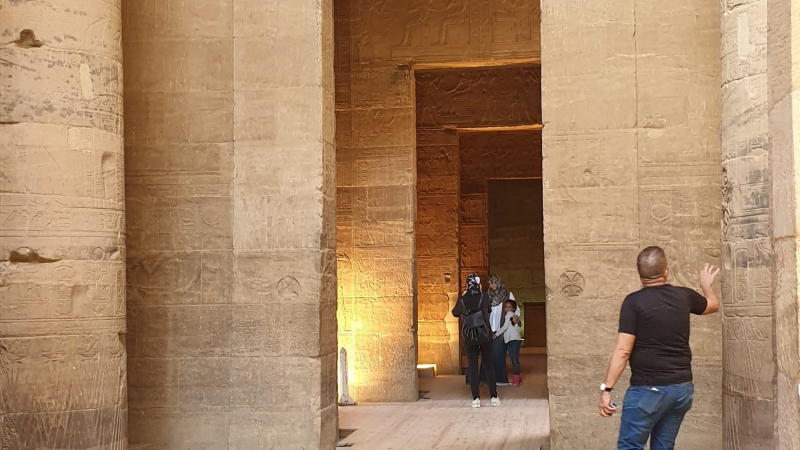
Me enjoying the felucca ride to the Philae Temple

Enjoying a Fish Dinner
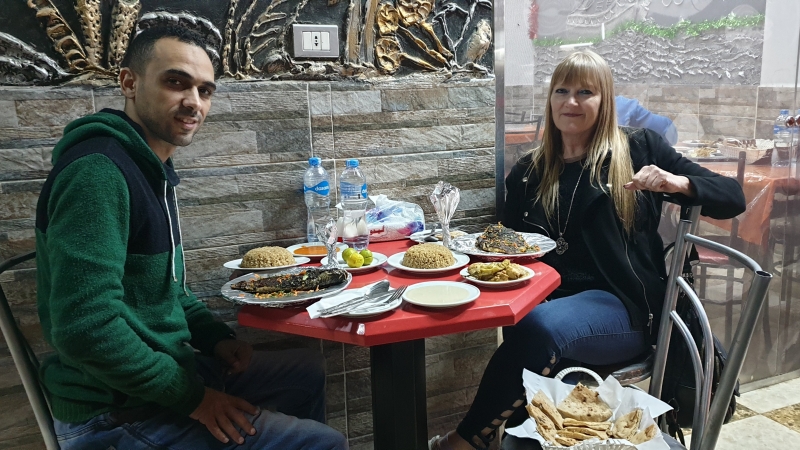
On Walkabout in Aswan
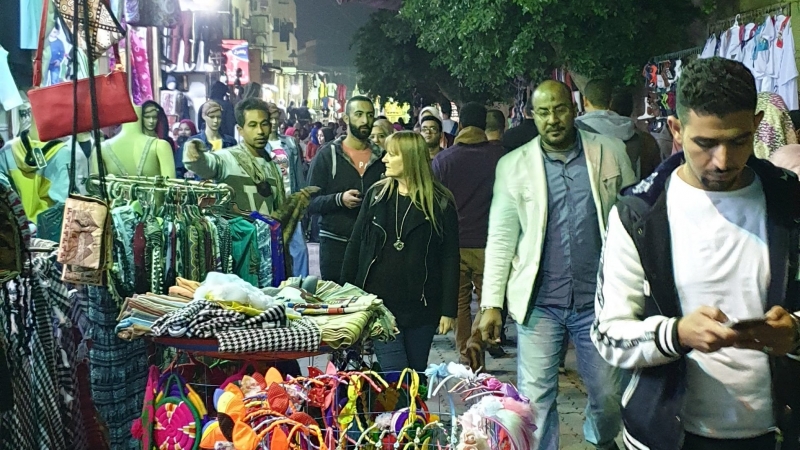
So many spice stores in the street
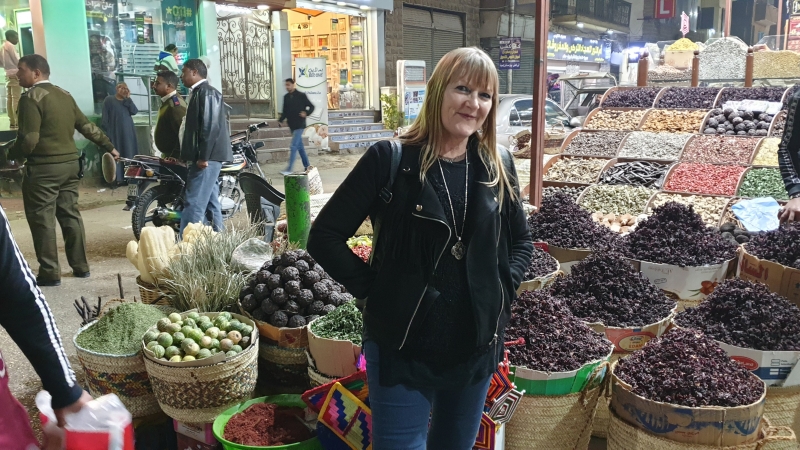
Coffee Time!

Day 4. January 24th. The Temple of Horus in Edfu.
The Temple of Horus is an Egyptian temple located on the west bank of the Nile in Edfu, Upper Egypt. The city was known in the Hellenistic period as Koine Greek: Ἀπόλλωνος πόλις and Latin Apollonopolis Magna, after the Falcon god Horus, son of Isis and Osiris, who was identified as Apollo under the interpretatio graeca. It is the largest and one of the most preserved temples dedicated to Horus and Hathor of Dendera. With its roof intact, it is also one of the most atmospheric of ancient buildings and was preserved by desert sand, which filled the place after the pagan cult was banned.
There is so much history to read about Isis, Osiris and Horus and too much to write here, so if you’re interested to learn more you can be sure to find all you want to know from the internet such as Wikipedia and Lonely Planet plus others.
After leaving Edfu Temple we traveled to our next destination and checked into the delightful 5* Mercure Luxor Karnak Hotel in Luxor for 2 nights. The other choice of 5* hotels you can choose to stay in this area in Luxor is at Hilton Luxor Resort or Sofitel Winter Palace.
This hotel is situated close to the banks of the Nile and is the only one in Egypt to resemble Ancient Ruins. You will notice and feel its surroundings of breathless and timeless exotic beauty. It was so beautiful to see at night with glowing lights shining on the buildings all around the grounds.
The hotel rooms are very clean and comfortable and staff exceptionally helpful and of course very friendly too. The food was as you’d expect from a 5* resort and a great variety of choice was available for a hearty breakfast. I’m happy to say their coffee was also up to my liking so it certainly help to start my day on a good note!
Accommodation: Mercure Luxor Karnak is family resort categorized five stars (local rating) featuring different room types; 325 standard rooms plus 22 suites «either corner or junior suites» they are all with its peaceful garden view, ground and first floor, all reflects the atmosphere of the region with its Moorish style. Attractions nearby of Luxor Karnak Temple, Luxor Temple, Valley of the kings , Valley of queens and Luxor Museum.
Watching the sunset over the River Nile from the Pyramisa Isis Corniche Hotel in Aswan

View of the Nile from the hotel restaurant in Aswan
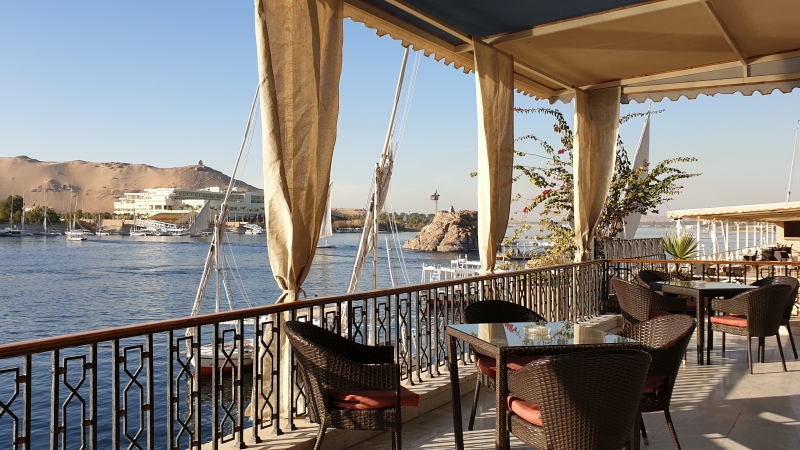
Breakfast at the Pyramisa Isis Corniche Hotel before setting off to Edfu Temple

View of the beautiful Nile from Aswan
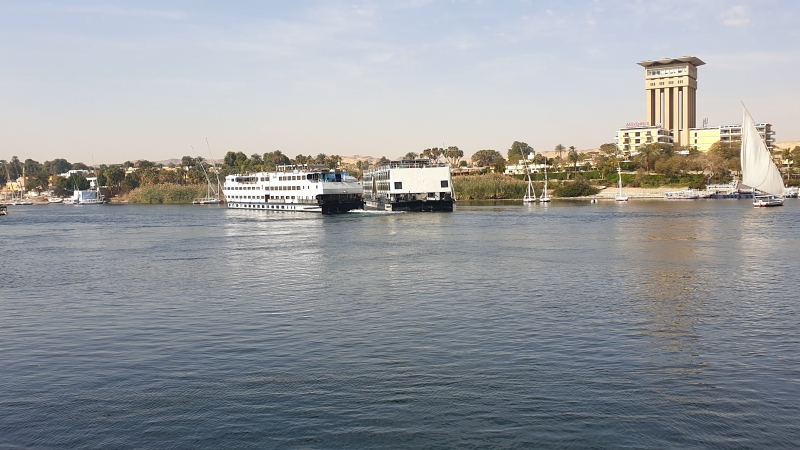
Me at Edfu Temple

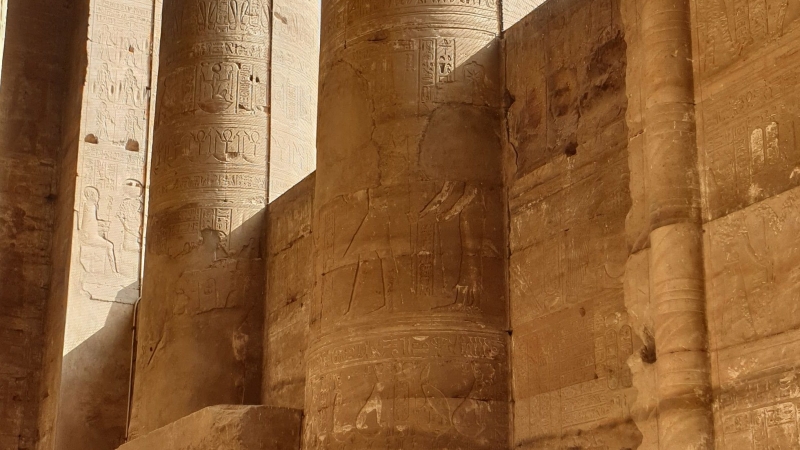
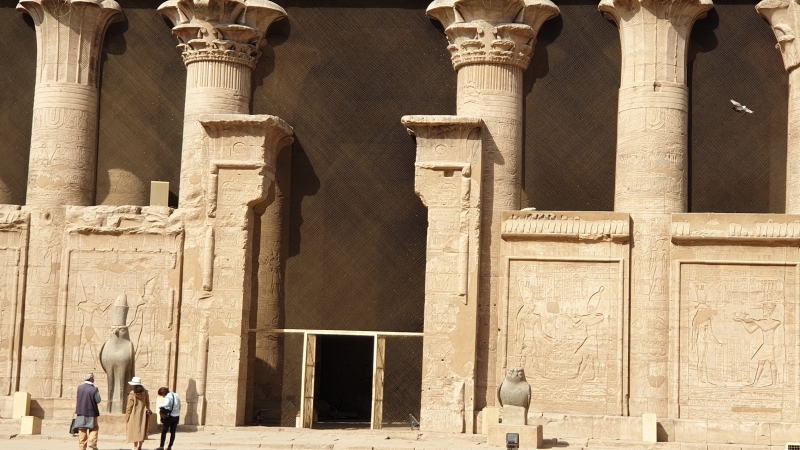



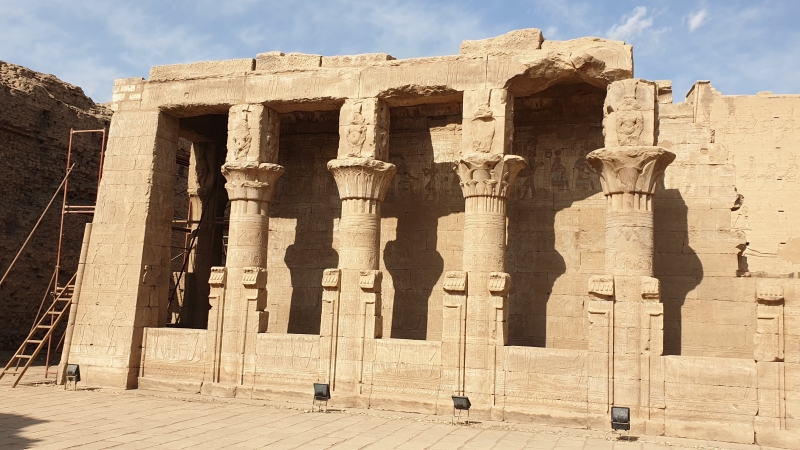

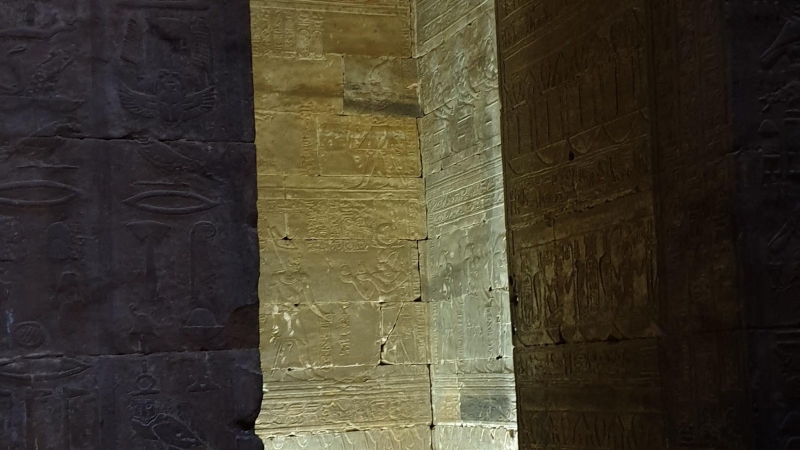
5* Hotel Mercure Karnak Luxor
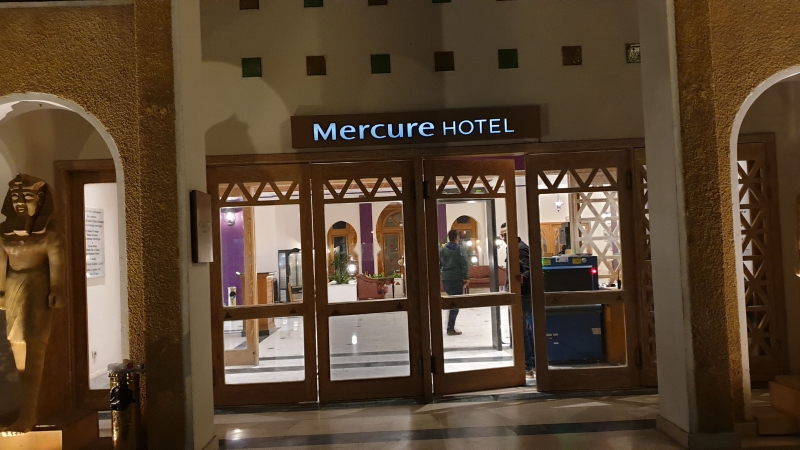

Hotel Reception

Double Delux Room with Pool View Balcony



A misty start to the morning over the Nile

Pool view as the sun goes down

Villa view from my balcony


El Hussein Restaurant, Luxor

Menu

Lentil Soup for starter


Traditional Egyptian Evening Meal
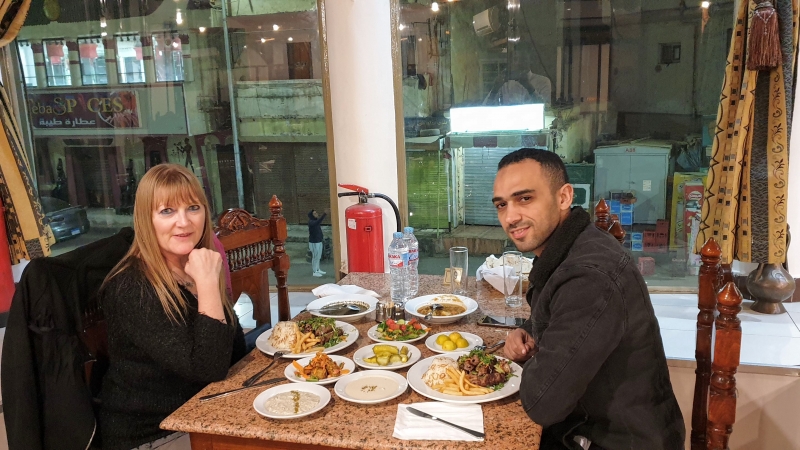

Colossi of Memnun
The day began with a visit to the Colossi of Memnun (Arabic: el-Colossat or es-Salamat) and are two massive stone statues of the Pharaoh Amenhotep III, who reigned in Egypt during the Dynasty XVIII. For the past 3,400 years (since 1350 BC), they have stood in the Theban Necropolis, located west of the River Nile from the modern city of Luxor.
The Description of Colossi of Memnon
Carved from single blocks of sandstone, each one of them weighs 720 tonnes and stand 18 meters high. They are two-seated king statues on a throne ornamented, representing the pharaoh wearing the royal headdress of the Nemes, protected by the divine cobra. The hands of the king are resting on his knees and he directs his face towards the eastwards toward the Nile River. There are two small figures carved into the front part of the statues that represent his wife Tiye and mother Mutemwiy. The two statues are quite damaged but they remain as symbols for the amazing Egyptian Civilization and culture and were built as guardians for Amenhotep’s mortuary complex.
The Grand Mortuary Complex
The Mortuary complex built by Amenhotep III was the largest and the biggest building that has ever been built in Egypt. It was even more inspiring than Karnak Temple. It included numerous rooms, halls, and plateaus, which mirrored the vision of the Field of Reeds, the Egyptian paradise. Sadly, very little remains today of Amenhotep’s temple as it ruins after the disastrous earthquakes and floods in Egypt.
Colossi of Memnon symbolize the rule of the king over Egypt. The three figures in the statues, Amenhotep III, his wife Tiye, and his mother Mutemwiya are all symbols of rebirth. They have withstood all the natural disasters that they faced.
The Greek Mythology About Colossi of Memnon
According to the great Greek Mythology, Memnon, who is the mortal son of Eos, the goddess of Dawn, was slain by Achilles. The two statues were also believed to be singing statues probably because an earthquake shattered the upper part of them, which caused noise every day at dawn from the statues as the wind blew through them. Many theories have been said about the mystery of the sound of the two statues and till today, it remains a confusing and a mysterious matter.
Who is Memnon!
Memnon was a hero of the Trojan war. He was also the Ethiopian king who led his armies from Africa towards Asia to defend the beleaguered city. At the end, he was slain by Achilles. The two statues generally refer to the entire Theban Necropolis as the “Memnonium”; the name that is popular for more than 2000 years.
A stroll along the banks of the River Nile before breakfast
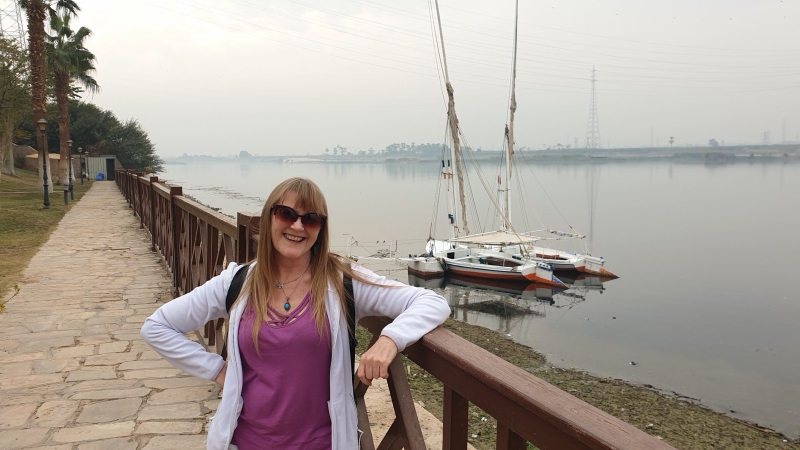
A filling breakfast overlooking the pool with my guide before starting our day out.
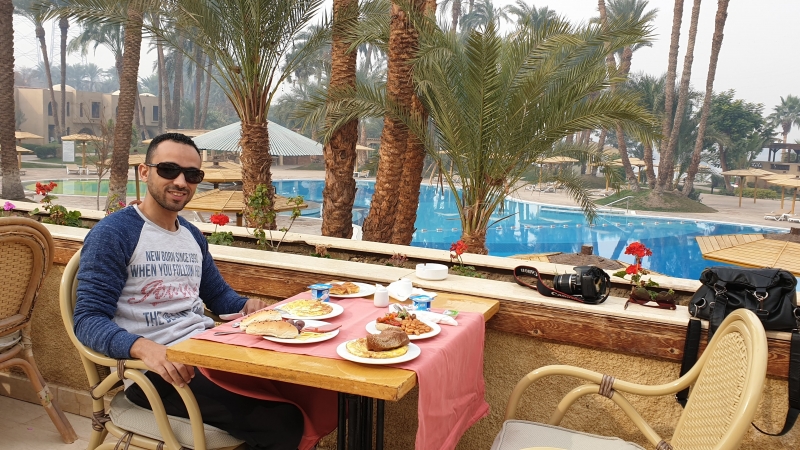
Colossi of Memnun
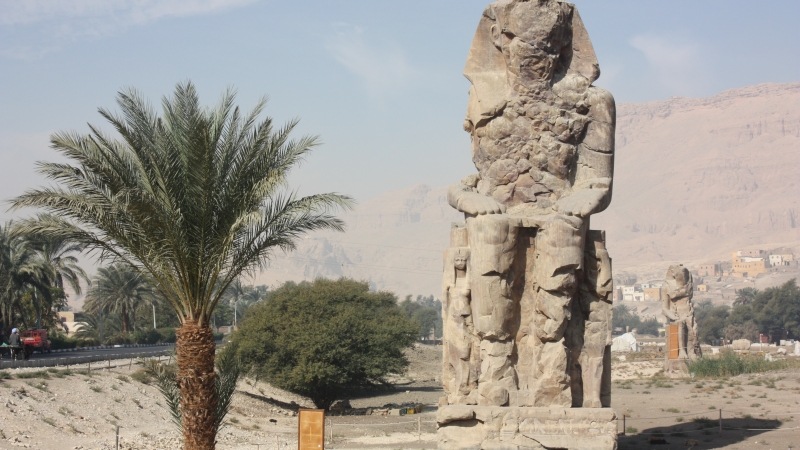

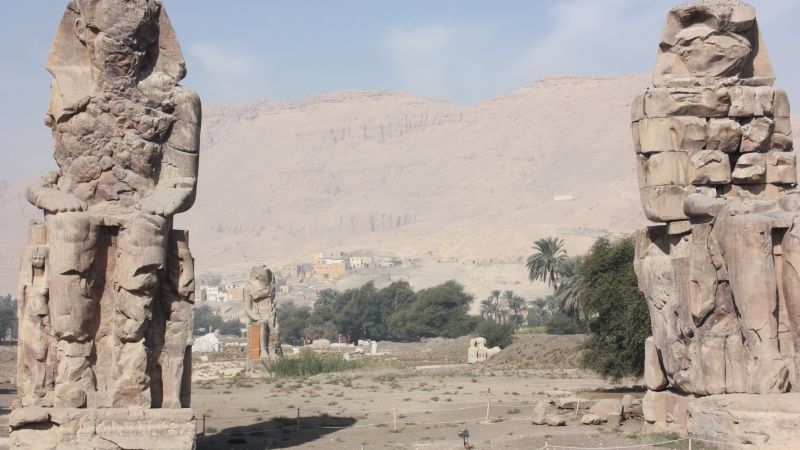
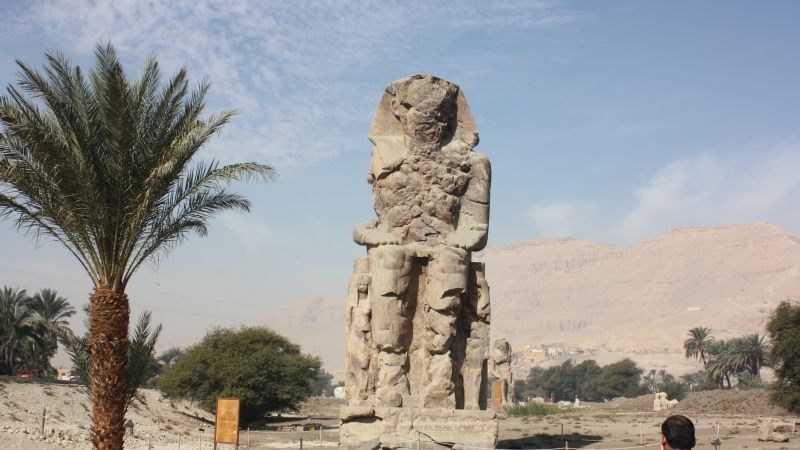



Valley of The Kings (“the Gateway to the Afterlife.”)
Facts About the Valley of The Kings.
On the west bank of the Nile lies the Valley of the Kings, once part of the ancient city of Thebes, and a necropolis used to house the bodies and belonging of many pharaohs from 18th, 19th and 20th Dynasties, Thutmose I and all the way until Ramesses X or XI. There are 63 tombs in this burial complex located in the hills of Dayr- al-Bahri, built there between 1539 BC to around 1075 BC.
The Valley of the Kings had been used as a royal burial complex for almost 500 years. The first tomb discovered by archaeologists was of pharaoh Ramses VII, though unfortuntely, most of the tombs of the Valley of the Kings are not open to the public. However, the ones that are open are highly recommended to view for their ancient history and magnificence. I for one was so overwhelmed with what I was seeing and just by being here. I couldn’t stop taking photos and videos, and some tombs were still so vibrant in their original colour. It was awesome!
Even though most of the tombs that are located in this valley have been robbed and looted the remains of these ancient burial sites give archaeologists and historians an estimate of the power of ancient Pharaohs and noblemen.
During Roman times the valley of the kings was a very attractive touristic location. You will notice that many of the tombs have graffiti written by ancient tourists; researchers have located over 2100 ancient graffiti, mostly Latin and Greek.
The burial site of Tutankhamun is one of the most famous in the entire Valley of the Kings. The tomb of Tutankhamun was one of the first royal tombs to be discovered that was still largely intact, even though robbers had already accessed it in the past.
Valley of The Kings

Valley of The Kings


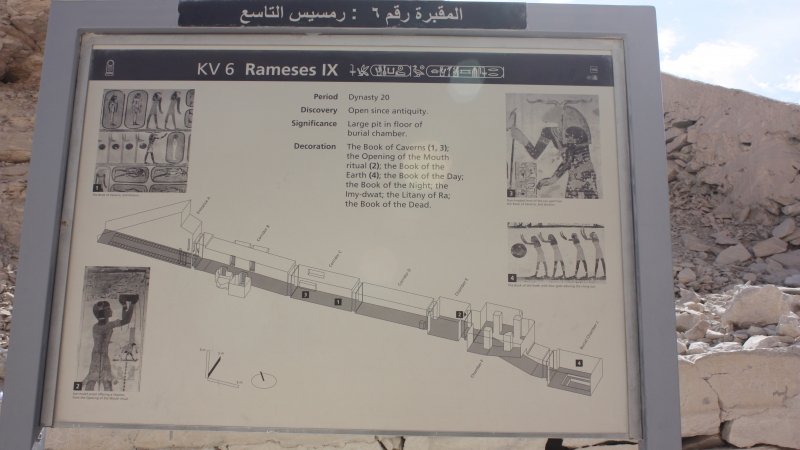
See how amazing these transcriptions and drawings still look after around 5,000 years!!





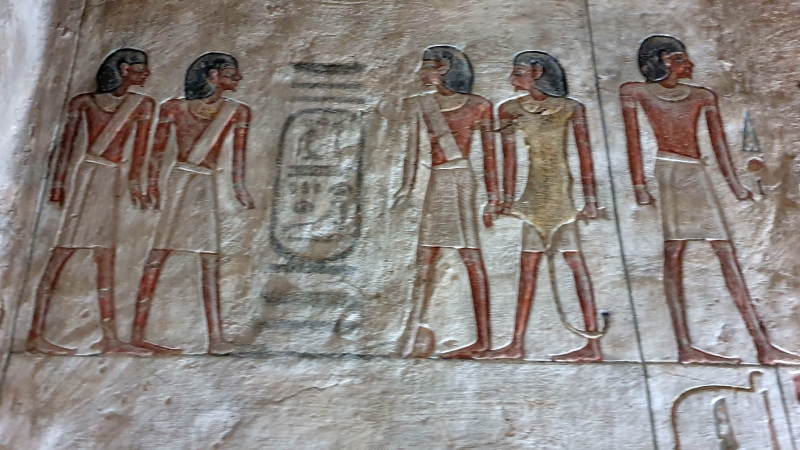



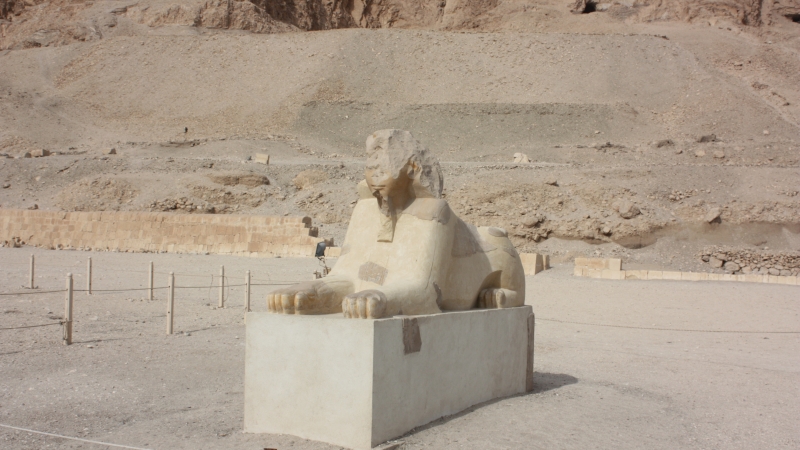

Hatshepsut Temple

Hatshepsut Temple

As you can see from the photos, like me, you’ll probably first focus your eyes upon the dramatic rugged limestone cliffs that rise almost 300m above the desert plain, though sure enough you’ll soon realise that at the foot of all this immense beauty lies a monument even more extraordinary, the extremely impressive Temple of Hatshepsut. I was a little confused at first because it actually looked quite new and blends in beautifully with the cliffs from which it is partly made. The reason it looks so ‘new’ is that it has been painstakingly reconstructed.
Back in the days of Hatshepsut (1473-1458BC), it must have been much more stunning as it was approached by a grand sphinx-lined causeway instead of today’s noisy tourist bazar, when the court was an attractive garden planted with exotic trees and perfumed plants, and when it was linked due east across the Nile to the Temple of Karnak.
The Mortuary Temple of Hatshepsut, also known as the Djeser-Djeseru, is a mortuary temple of Ancient Egypt located in Upper Egypt. Built for the Eighteenth Dynasty pharaoh Hatshepsut, it is located beneath the cliffs at Deir el-Bahari on the west bank of the Nile near the Valley of the Kings.
Hatshepsut was the fifth pharaoh of the 18th Dynasty of Egypt. She was the second historically-confirmed female pharaoh, the first being Sobekneferu and came to the throne of Egypt in 1478 BC. Hatshepsut was the longest reigning female pharaoh in Egypt, ruling for 20 years in the 15th century B.C. She is considered one of Egypt’s most successful pharaohs.
A daughter of King Thutmose I, Hatshepsut became queen of Egypt when she married her half-brother, Thutmose II, around the age of 12 and in order for people to accept her as pharaoh, Hatshepsut began to dress like a pharaoh. She wore the pharaoh’s headdress with a cobra. She even wore a fake beard and a short kilt like the men wore. Hatshepsut died after 22 years of rule.
On the south side of Hatshepsut’s temple lie the remains of the Temple of Montuhotep, built for the founder of the 11th dynasty and one of the oldest temples thus far discovered in Thebes, and the Temple of Tuthmosis III, Hatshepsut’s successor. Both are in ruins.
Yet again, a fabulous time here and amazed by everything. Extremely happy to be experiencing such ancient wonders!
Hatshepsut Temple

Hatshepsut Temple

Hatshepsut Temple

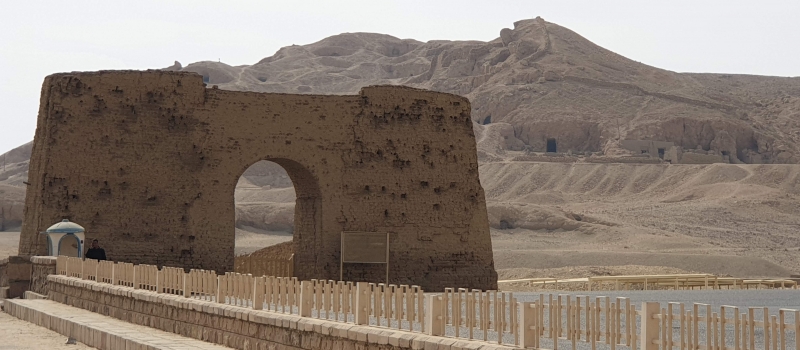

Hatshepsut Temple

After spending the day visiting these wonderful ancient wonders I was pretty much exhausted and was much in need of food and have a well earned rest! We stopped for dinner at a place called ‘Georgina’s.’ When I saw the name of the restaurant I just had to choose this place as it is my Mother’s name. I thought it was a strange name to call an Egyptian Restaurant so, being nosey (lol), I asked the reason for this name. The manager told me it was the name of the owners daughter as her mother was Italian and chose the childs name and therefore, named the restaurant after her.
We dined on a 3 course meal of vegetable soup, fish with a delicious aromatic sauce, rice and vegetables, followed by a complimentary fruit plate each consisting of slices of orange, Guava, (which was a first for me, as I had never experienced it before), although I didn’t dislike it I wouldn’t necessarilly choose it next time, and dates.
The atmosphere in the restaurant wasn’t a particularly cosy feeling as the surroundings were of a dark varnished wood and walls were decorated by pictures of people that weren’t in the slightest bit interesting to look at, though it didn’t really matter, as the important part was the good food and friendly staff.
Georgina's Restaurant

Georgina's Restaurant

Fish with rice and vegetables. Very tasty!!
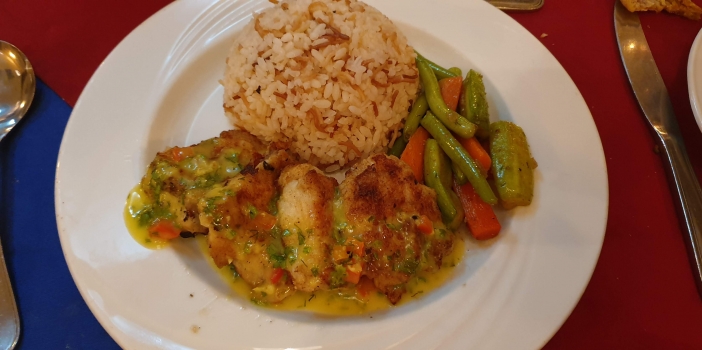
Fish with rice and vegetables

Although we waited quite a while for the food it was worht the wait!
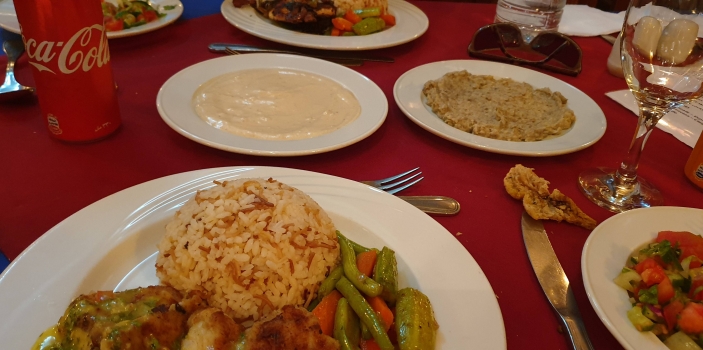
Complimentary Guava, orange segments and dates.

Day 6. We spent relaxing at the hotel after the previous day being so busy. After dinner in the evening we headed into Luxor to find a cafe close to the Temple to enjoy a perfect cup of Turkish coffee before the sunset. We deliberately waited until after sunset because the Temple of Luxor is best viewed at night as the lights project a beautiful warm glow all over the walls, statues and collumns. You’ll notice that it is very busy as most tours are conducted in the evening here. Tours come in the big bus loads one after the other and use up all the parking spaces. They seemed to be mainly Korean and a few Japanese amongst other tourists.
Temple of Luxor
Largely built by the New Kingdom pharaohs Amenhotep III (1390–1352 BC) and Ramses II (1279–1213 BC), this temple is a strikingly graceful monument in the heart of the modern town. Also known as the Southern Sanctuary, its main function was during the annual Opet celebrations, when the statues of Amun, Mut and Khonsu were brought from Karnak, along the Avenue of Sphinxes, and reunited here during the inundation.
Amenhotep III greatly enlarged an older shrine built by Hatshepsut, and rededicated the massive temple as Amun’s southern ipet (harem), the private quarters of the god. The structure was further added to by Tutankhamun, Ramses II, Alexander the Great and various Romans. The Romans constructed a military fort around the temple that the Arabs later called Al Uqsur (The Fortifications), which was later corrupted to give modern Luxor its name.
In ancient times the temple would have been surrounded by a warren of mud-brick houses, shops and workshops, which now lie under the modern town, but after the decline of the city people moved into the – by then – partly covered temple complex and built their city within it. In the 14th century, a mosque was built in one of the interior courts for the local sheikh (holy man) Abu Al Haggag. Excavation works, begun in 1885, have cleared away the village and debris of centuries to uncover what can be seen of the temple today, but the mosque remains and has been restored after a fire.
The temple is less complex than Karnak, but here again you walk back in time the deeper you go into it. In front of the temple is the beginning of the magnificent Avenue of Sphinxes that ran all the way to the temples at Karnak 3km to the north, and is now almost entirely excavated. That really must have looked absolutely amazing back then and what we now are actually able to see still looks rather impressive.
Afterwards we found a cafe where we could play Backgammon (tavla). I’ve played many times before but found that Egyptian’s have different rules than Turkish and English players. While we played, we drank salep, or actually I should say ate salep. In Turkey we drink salep as it’s a milky drink flavoured with cinnamon but in Egypt it is white and thick like custard with spices and fruit such as strawberries, apple slices and one banana sliced up on-top, so you eat it with a spoon. I didn’t like the Egyptain backgammon rules though it was interesting to play a different style. I lost of course!
Luxor Temple

Luxor Temple
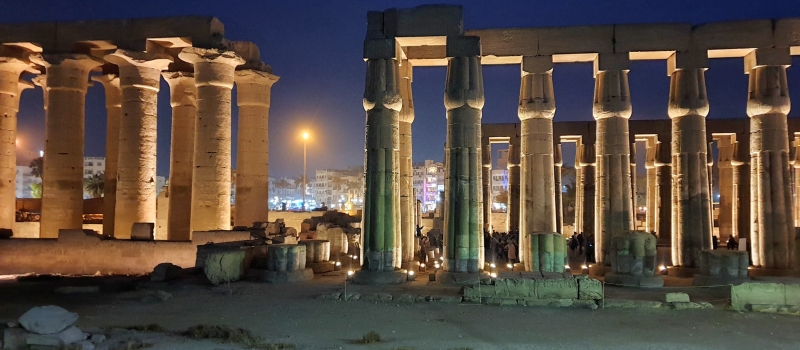
Luxor Temple

Inside Luxor Temple
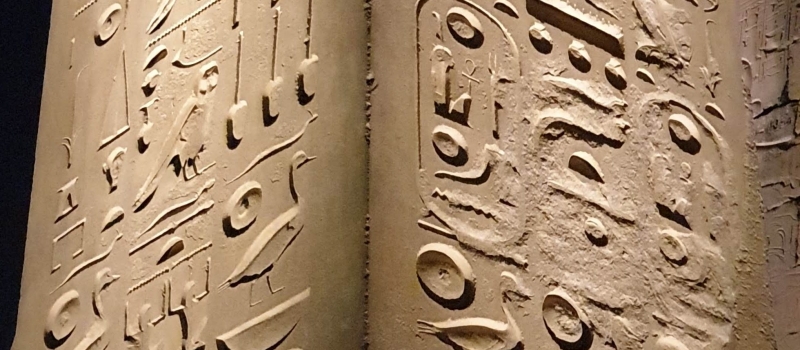
Inside Luxor Temple
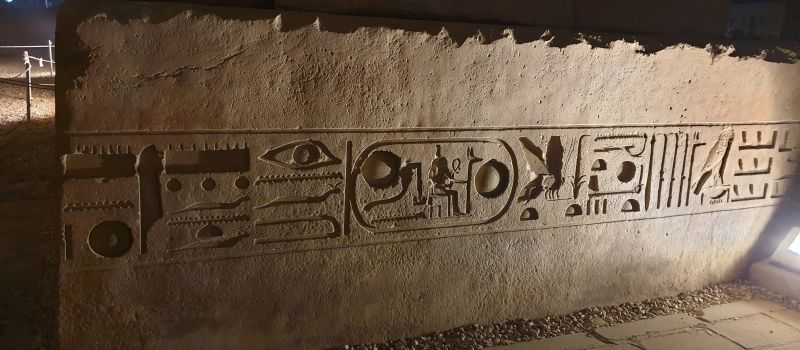
Inside Luxor Temple
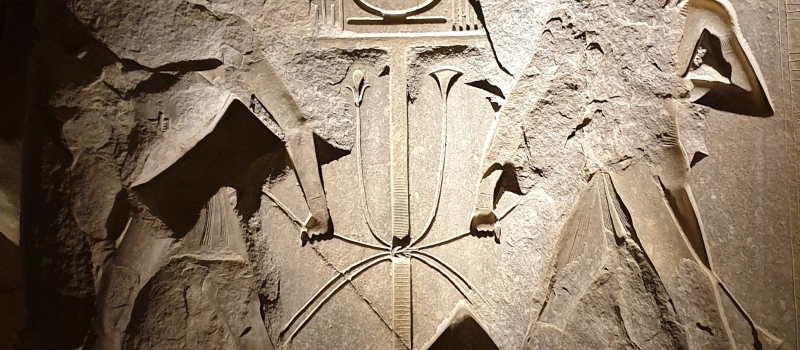
Inside Luxor Temple
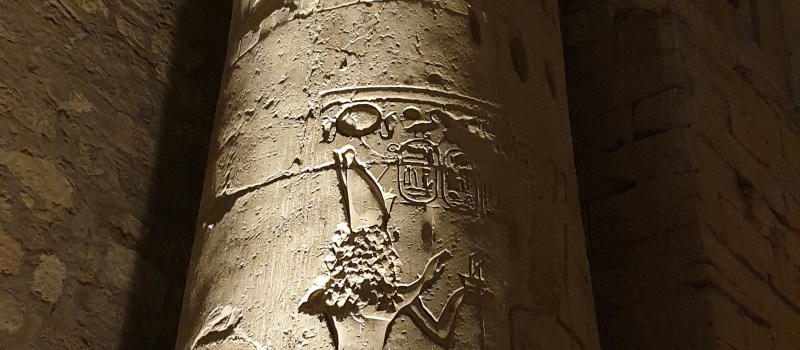
Inside Luxor Temple
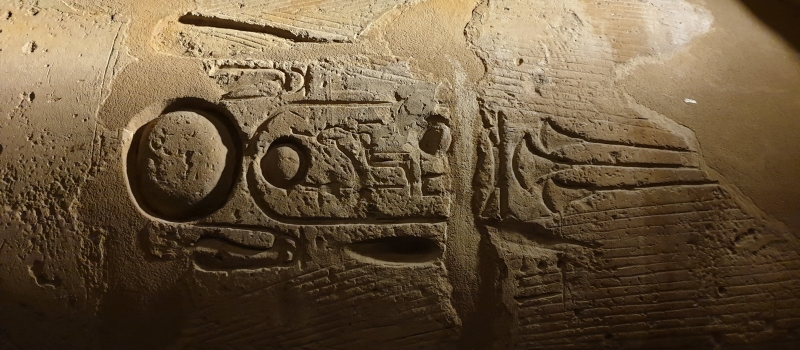
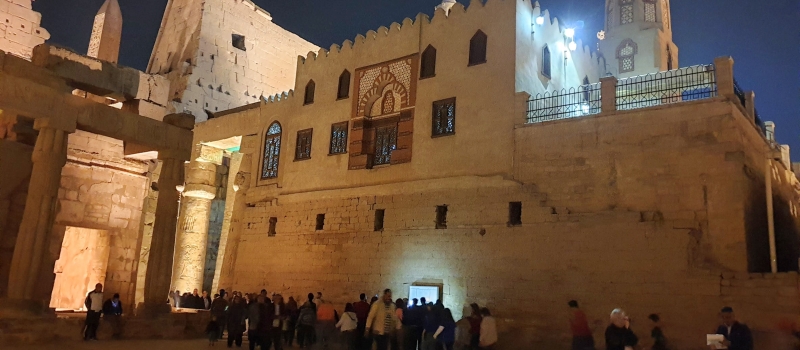
Inside Luxor Temple
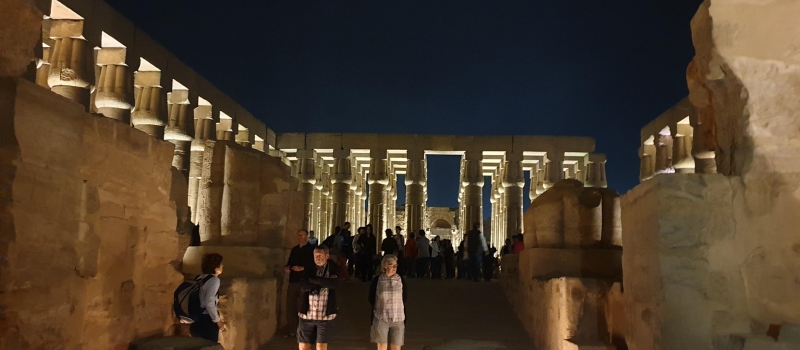
Inside Luxor Temple

Inside Luxor Temple

Across the road from Luxor Temple

Across the road from Luxor Temple

Across the road from Luxor Temple
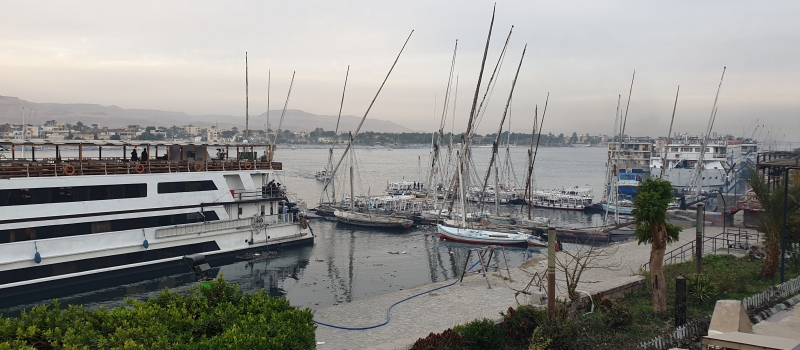
Horse and Cart Rides can be seen almost everywhere

Across the road from Luxor Temple

Cruise Ship Across the road from Luxor Temple

A game of Backgammon in Egyptian rules (Tavla)

Sahlep Egyptian Style is sooooo delicious!

Day 7. We spent the day relaxing and enjoying the facilities at the hotel before checking out at 15.30 and headed off to Karnak Temple before traveling back to Cairo.
Karnak Temple Complex
‘Karnak’, translated as “The Most Selected of Places” was the main Egyptian religious center during the eighteenth dynasty Theban Triad who widely worshiped the god Amun. Karnak is like an open air museum and the largest ancient religious site in the world. It’s also the second most visited place in Egypt after the Pyramids of Giza and is one of Ancient Egypt’s grandest building projects.
The Karnak Temple Complex, is a series of decayed temples, chapels, pylons, an obelisk that stands 97-feet tall and weighs 323-tons and other buildings constructed during the Ptolemic Era reign of Senusret I. There are other pharaohs that helped build the holy city but Senusret I is the most important. You enter the complex through a grand procession way, flanked on both sides by ram-headed sphinxes. These once ran all the way to Karnak from Luxor Temple (in downtown modern Luxor). During the Ancient Egyptian annual Festival of Opet, the statues of Amun, Mut, and Khonsu were paraded out of Karnak, down this avenue to Luxor Temple.
The Great Temple of Amun is Karnak’s main temple building, and similar to nearly all of Egypt’s surviving monuments, the temple has seen additions and improvements by a whopping 30-pharaohs who contributed to the construction over the centuries. Though, the shape of the temple you see before you now is mostly due to Pharaoh Tuthmosis I, who made Thebes capital of the New Kingdom and expanded the original modest temple here as it no longer seemed adequate to the power of the god and the king.
Most of your time in Karnak will be spent inside this awe-inspiring building, but don’t make the mistake of thinking this is all the Karnak complex has to offer, there’s so much more to learn and too much for me to write here so, if you’re keen to find out there’s much on the internet these days such as on lonelyplanet.com.
After spending around 2 and a half hours here, walking around in amazment, taking photos and videos we had worked up an appetite and so made our way to a restaurant called Elkerdasy King of The Liver. I usually enjoy eating liver but wasn’t sure if I wanted to try Camel liver. I’m usually up for trying new foods when in a different country so I decided I’d go for it. I was pleasantly surprised at how nice it was and I’ll definitely eat it again.
After dinner we traveled back to Cairo.
Entrance to Karnak Temple lined with shpinxes on both sides

Inside Karnak Temple
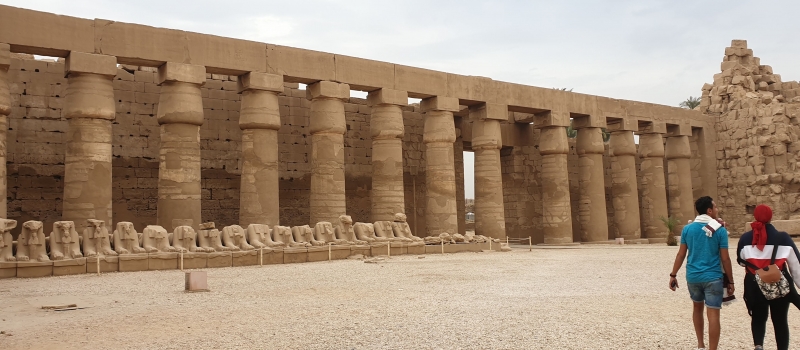
The importance of Karnak resided in its being the contact point between Amun, the supreme ruler of the universe, and the pharaoh, the supreme ruler on Earth who represented all Egyptian people
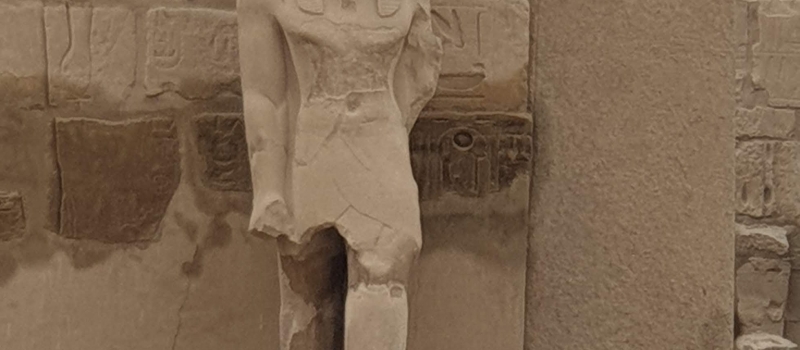
The Karnak Temple Complex, commonly known as Karnak, comprises a vast mix of decayed temples, chapels, pylons, and other buildings
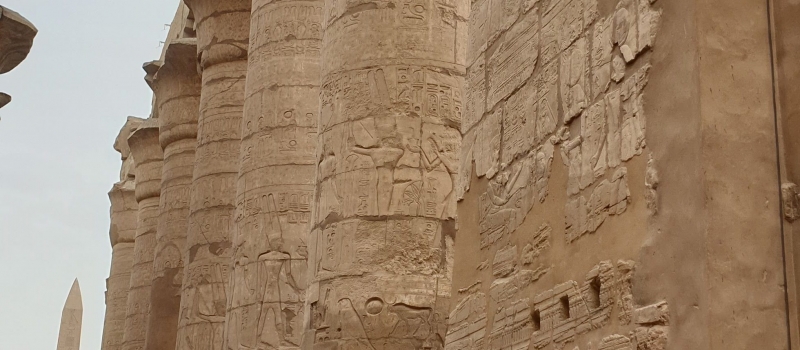
Amazing inscriptions on all the columns
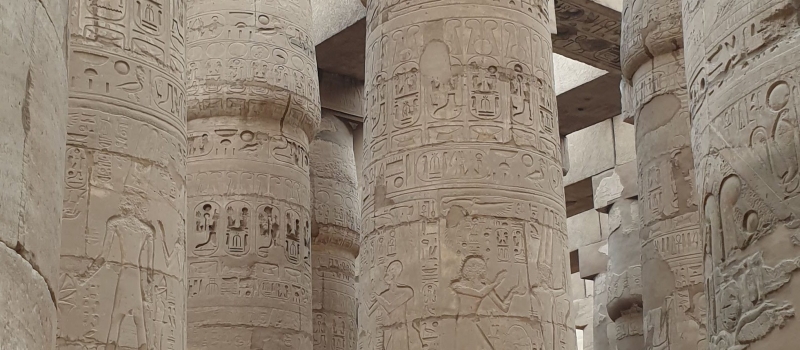
Hypostyle Hall Columns
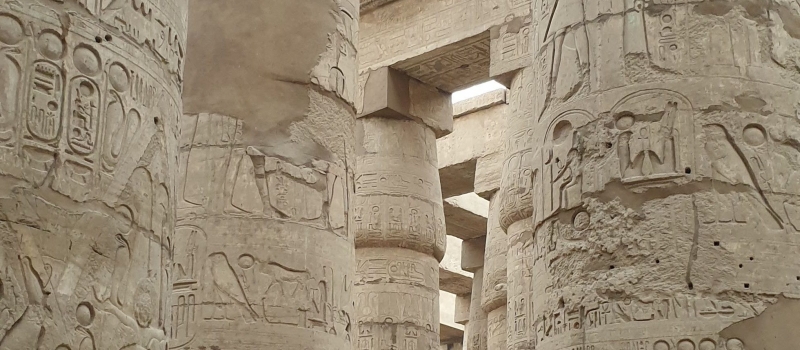
The temple of Karnak was known as Ipet-isu—or “most select of places”—by the ancient Egyptians.
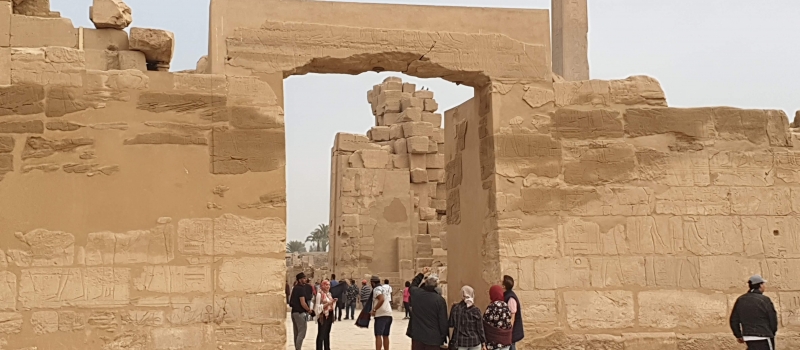
Cult temple dedicated to Amun, Mut and Khonsu. The largest religious building ever constructed.

Karnak Temple dates from around 2055 BC to around 100 AD.

The massive temple complex of Karnak was the principal religious center of the god Amun-Re in Thebes during the New Kingdom

Karnak consists of huge pillars, towering columns, massive avenues of sphinxes, and an obelisk that stands 97-feet tall and weighs 323-tons.
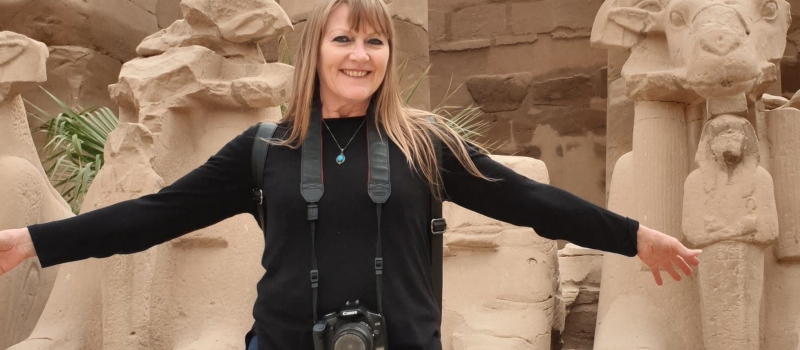
Tourist love to take their photos here with the rows of ram headed shpinxes

Karnak was built, appropriately, placed between the main sanctuary of Amun-Ra and the southern precinct that honored Mut.

Built by Ramesses III, a king who reigned from 1186 to 1155 B.C., the temple is about 230 feet (70 meters) by 88 feet (27 meters).
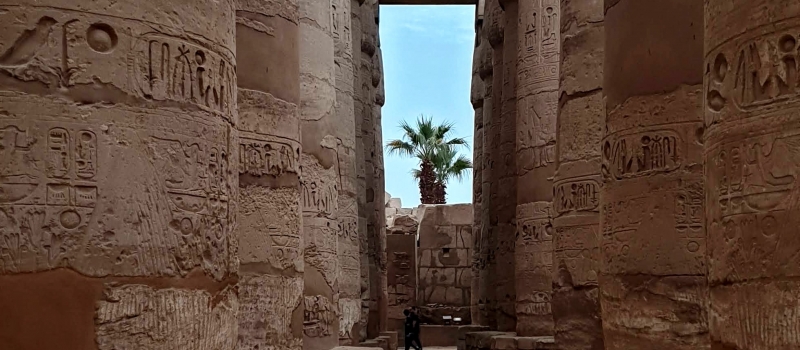
The central sector of the site, which takes up the largest amount of space, is dedicated to Amun-Ra, a male god associated with Thebes. The area immediately around his main sanctuary was known in antiquity as “Ipet-Sun” which means “the most select of places.”

Construction at Karnak started by 4,000 years ago and continued up until the time the Romans took control of Egypt, about 2,000 years ago.

A maze of walls and rooms

Hatshepsut was a female pharaoh of Egypt who reigned from roughly 1479 to 1458 B.C. At Karnak she renovated the main sanctuary at Karnak, creating in its place a “Palace of Ma’at.” She also created a chapel made of red quartzite to hold the god’s portable bark (boat).

When Hatshepsut’s successor, Thutmose III, came to the throne, he ordered the destruction of images of the female pharaoh and had her quartzite chapel destroyed and replaced with one of his own.

The obelisks at Karnak, Egypt. The obelisk on the right was erected by Thutmose I (reign c. 1520 - 1492 BCE) while that on the left by Hatshepsut (1479-1458 BCE).

King Taharqa, who reigned around 2,700 years ago, was part of a dynasty of rulers from Nubia (modern-day Sudan) who came to control much of Egypt. He was interested in Karnak’s “sacred lake” and built the “edifice of the lake” beside it, a partly underground monument.

Today it’s badly damaged although mysterious, would explain the open solar court above ground, while the subterranean rooms symbolised the sun’s nocturnal passage through the underworld.”

Karnak Obelisk

The pharaohs of the New Kingdom lavished attention on the Temple of Amun. ... The importance of Karnak resided in its being the contact point between Amun, the supreme ruler of the universe, and the pharaoh, the supreme ruler on Earth who represented all Egyptian people.

Elkerdasy King Of The Liver Restaurant

Elkerdasy King Of The Liver Restaurant
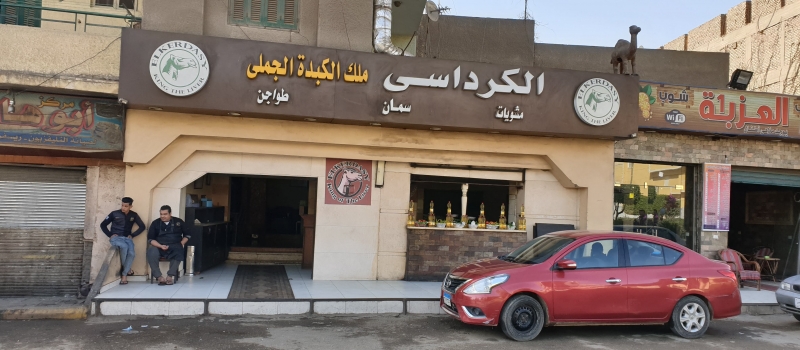
King Of The Camel Liver

Inside the restaurant

Me enjoying camel liver with my tour guide.

A display of oil for sale

Day 8. Khan el-Khalili Souk and El Fishawy Shisha Cafe.
First a relaxing kind of day, then in the evening we returned to the same Gad Restaurant as experienced on the first night for dinner, then drove to the famous Khan el-Khalili, which is a major souk in the historic center of Islamic Cairo and was established in the 14th Century. The bazaar district is one of Cairo’s main attractions for tourists and Egyptians.
While strolling round the souk, you will of course notice the unique mix of merchandise displayed in shops and the maze of narrow allies. There is a variety of goods — from sparkling silverware, gold artifacts and antiques, to stained glass lamps, incense, handmade accessories and ancient Pharaoh souvenirs. Also, the soft touch of the handmade carpets will take your breath away.
There are also districts for gold-selling, copper-made things and spice-selling. My favourite was the lamps, they have such an enchanting glow about them and would love to have bought them all! I can imagine these kind of lamps filling up my house would look magical.
After a browse round and a few photos, we stopped at a very famous old Cafe called El Fishawy, one of the oldest in Cairo (established in 1797) serving tea, coffee and shisha. Due to it’s fame it is open every day 24/7 and always full so, we had to squeeze into a corner in the hope that soon, al least some people might leave.
We sat at a small hand carved round wooden table and ordered Turkish Coffee. Instantly my eyes caught the decor and scanned the room from top to bottom. Most prominant was an over sized mirror (which almost filled one wall) of dark wood with an intricately hand carved frame, complete with a layer or two of dust.
There were portrait paintings of the founder and old photos of visitors, some also famous, from way back dotted about all over the walls and glowing lamps hung from the ceiling. Live music filled the room and onlookers sang along to the lively trio of traditional Egyptian music while even more people tried to squeeze into the room. Wafting through the air was a mixed aroma from the shisha pipes and coffee, which all added up to a wonderful atmosphere. We stayed for well over an hour then had to fight our way out of the cafe back into the narrow streets to have one last browse before heading back to the hotel.
Khan el Khalili Souk

Everything was so shiny and magical.

The brightest of all the little shops in the souk
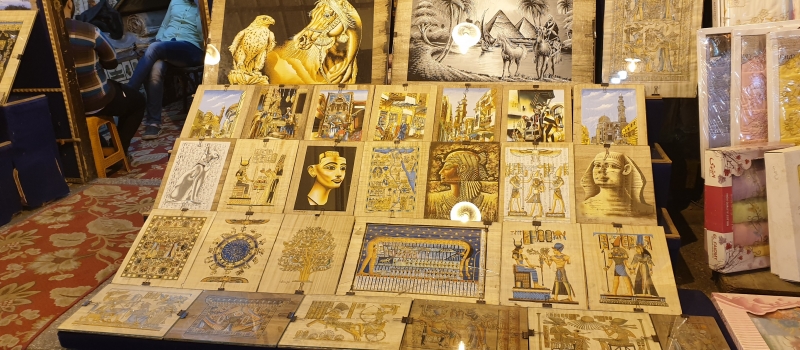
An array of elaborately designed trinkets, ormaments and souvenirs
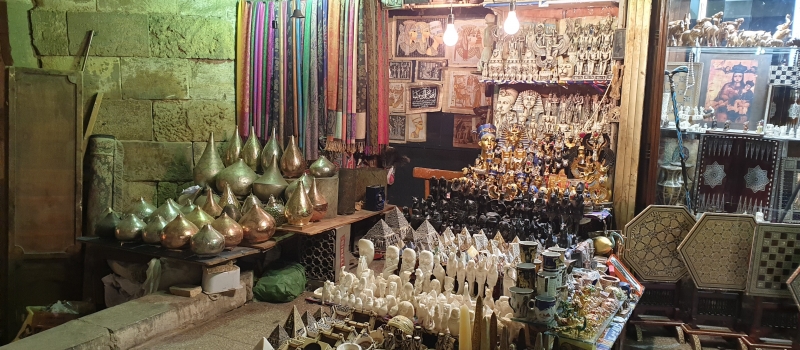
Constant hustle and bustle 24/7 around the El Fishawy Shisha Cafe

Turkish Coffee of course!

Turkish Coffee and assorted nuts

Enjoy Live traditional music while you sip your coffee and puff on your shisha!

Pictures of the founder and memories of times gone by
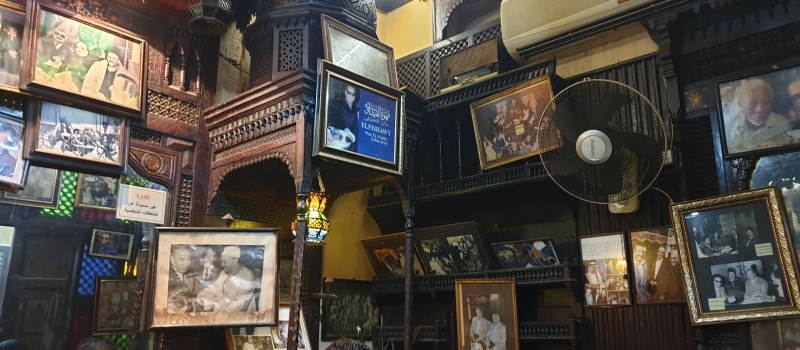
The view from a corner inside the tiny cafe from when it first opened before tables and chairs were used in the alleyway.
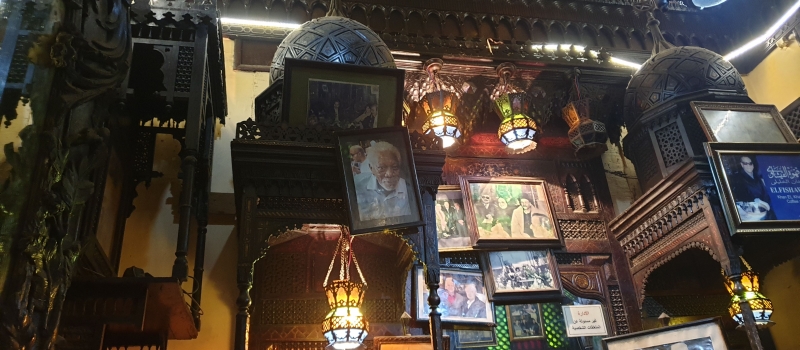
Elaborate shiny jewellery
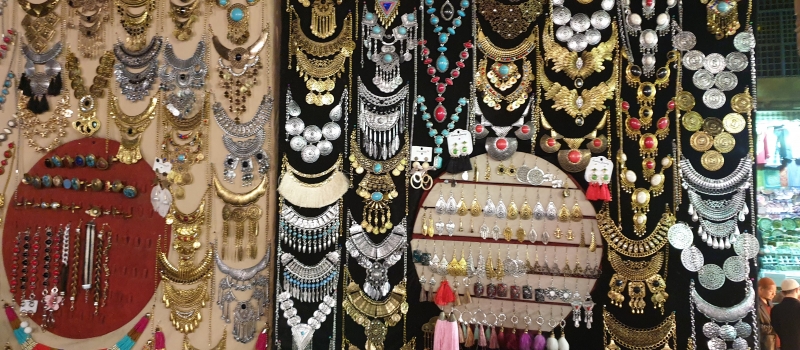
Shoppers browsing the souk

Many shops have similar items but may differ slightly in the price.
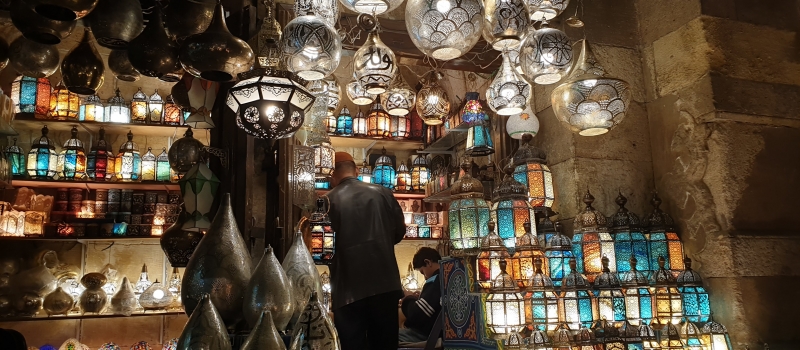
Love the colourful glowing lamps

Having difficulty deciding what to buy as a souvenir.
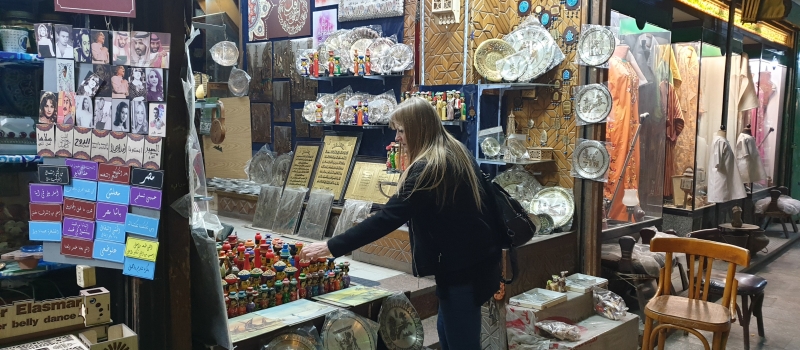
Now this beautiful looking entrance to a small gallery caught my eye so of course I had to snap it!
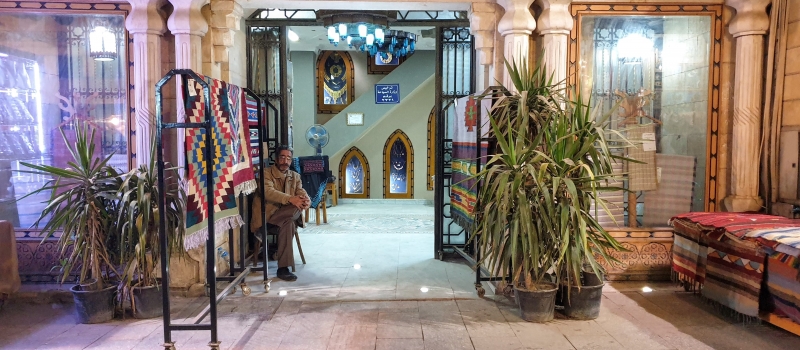
Day 9.
Sadly my trip has ended but I’ve had such an amazing time with so many wonderful memories. Thanks to Egyptoria for giving me the trip of a life-time, it was perfect! I’ve not finished exploring Egypt yet so I’ll be back another time to experience yet another magnificent time.
I hope you’ve enjoyed watching my videos, looking at my photos and reading my articles. And, if my article has inspired you to come and see for yourself all these wonderful places take a look through egyptoria website to see which tour you’d like to take, or maybe they can assist you in your own customised tour of your choice.




